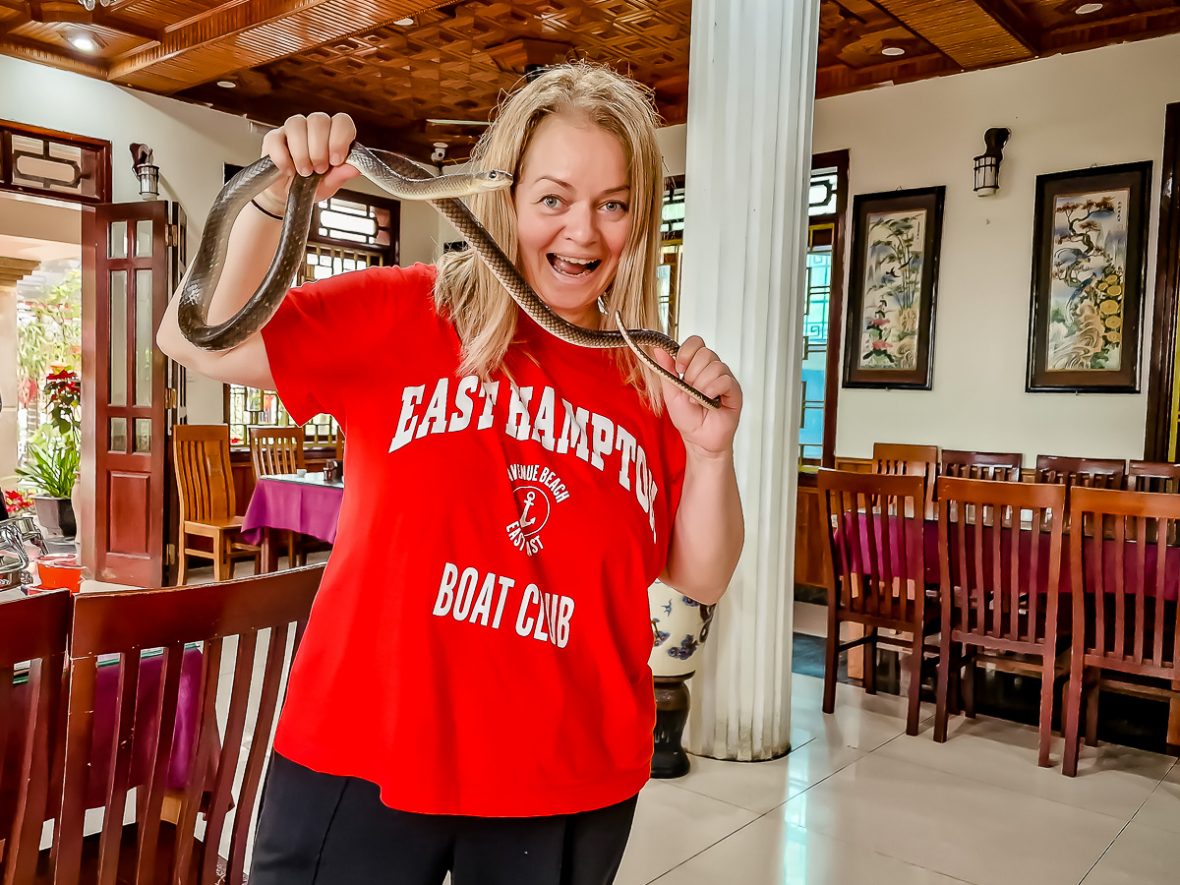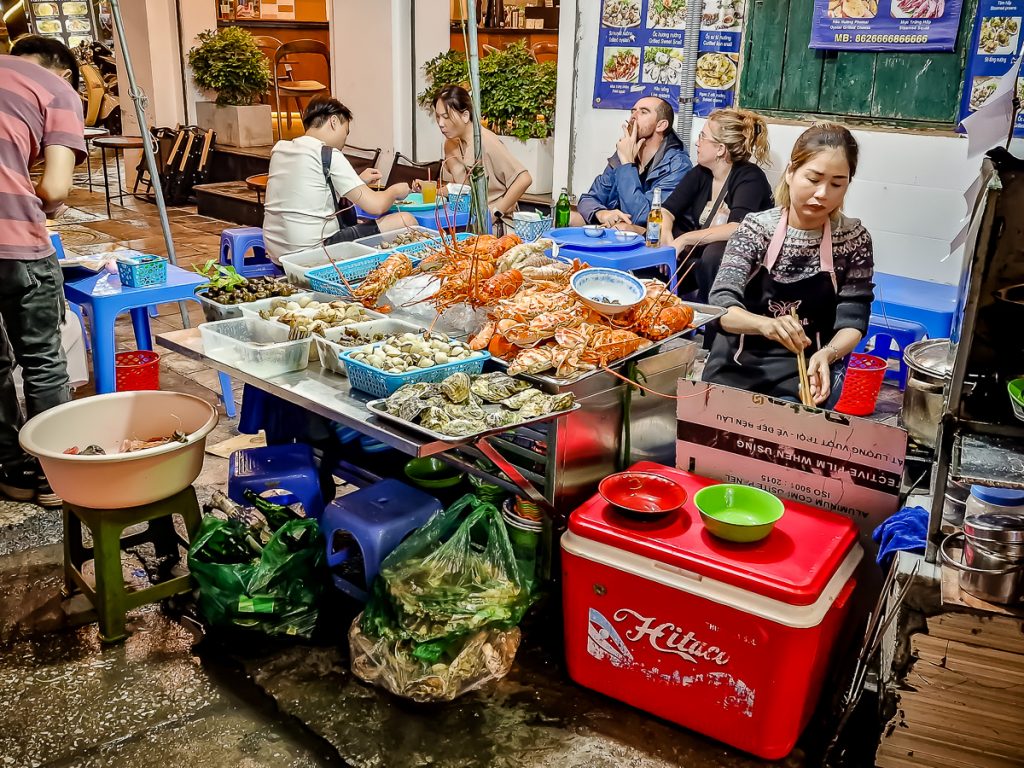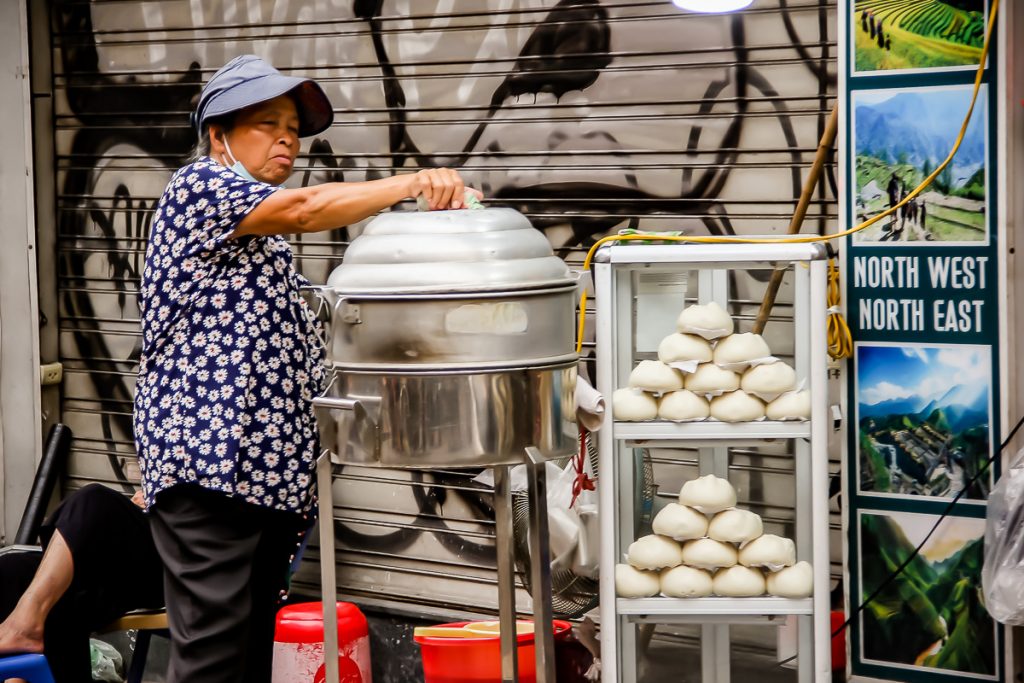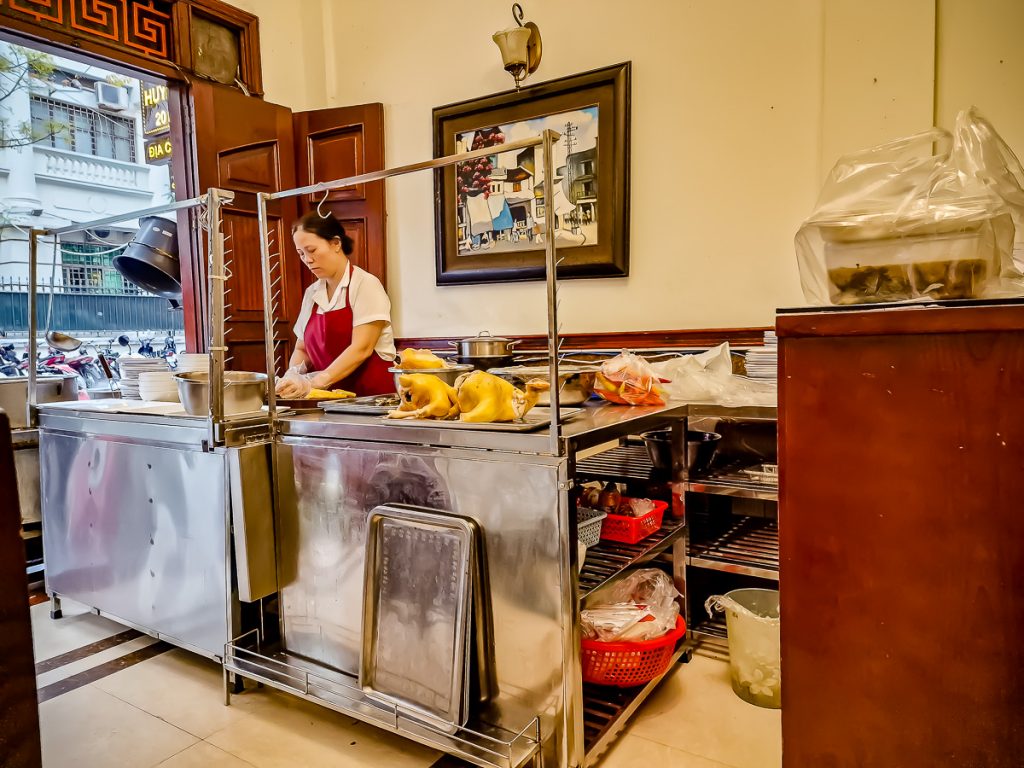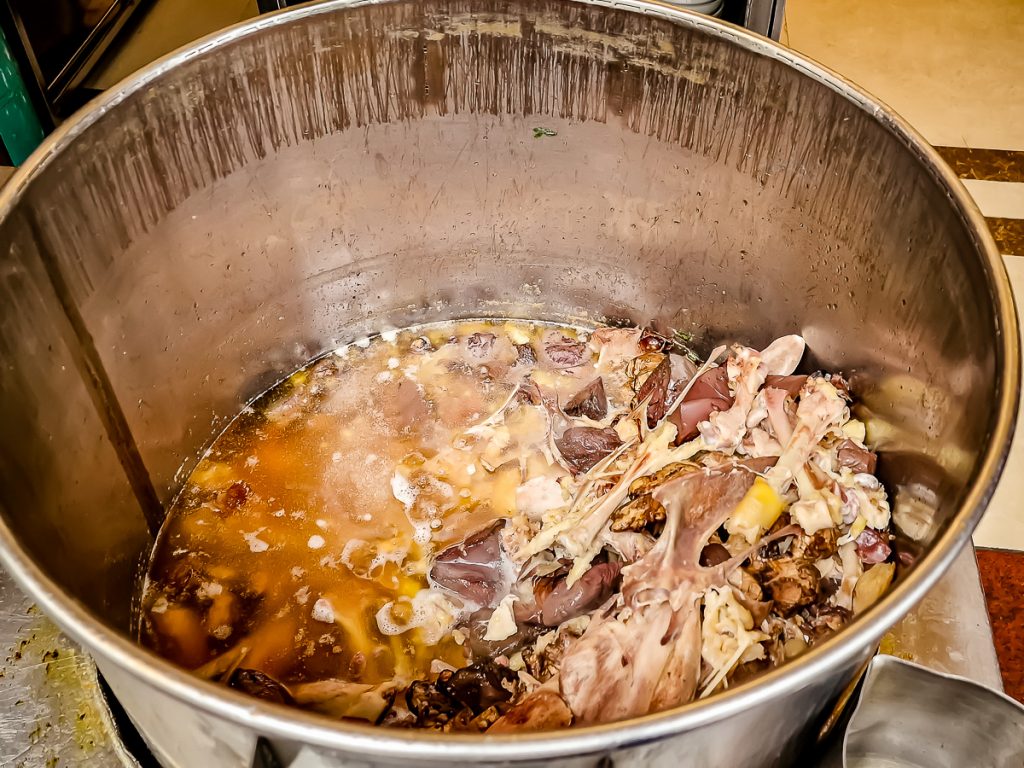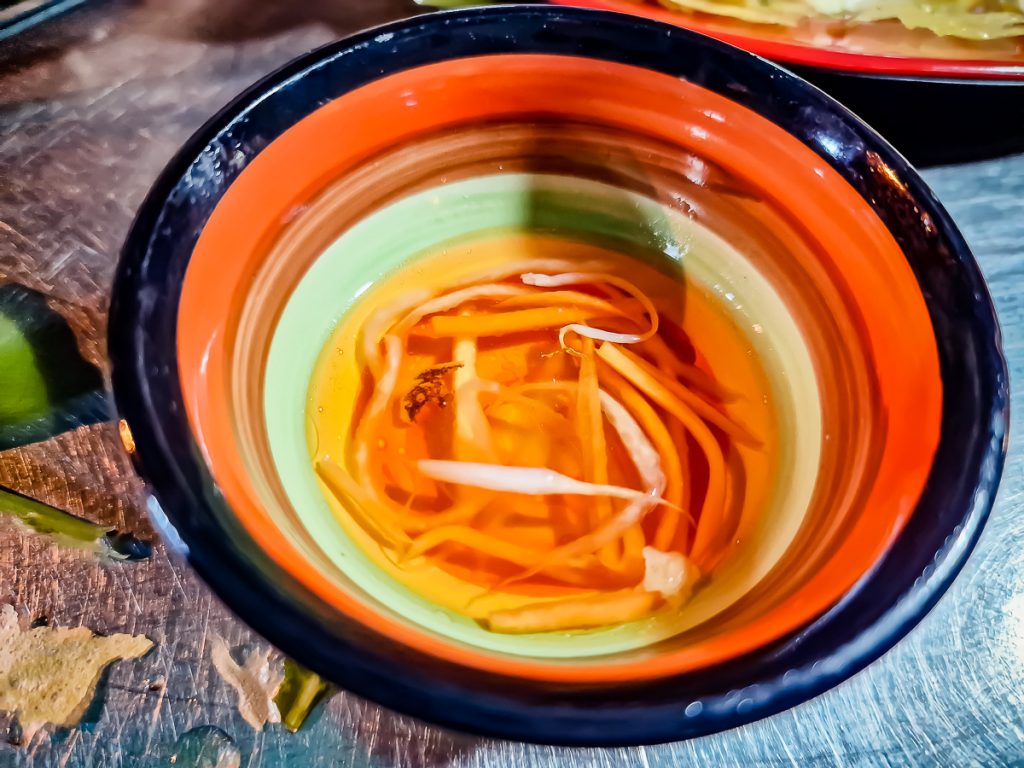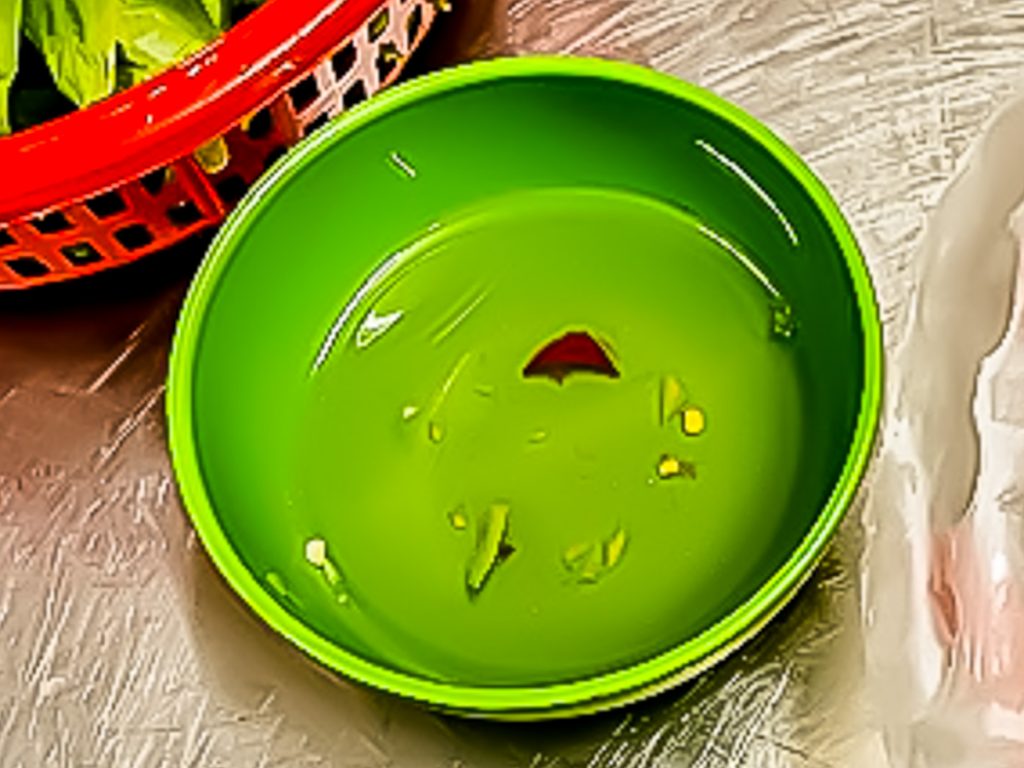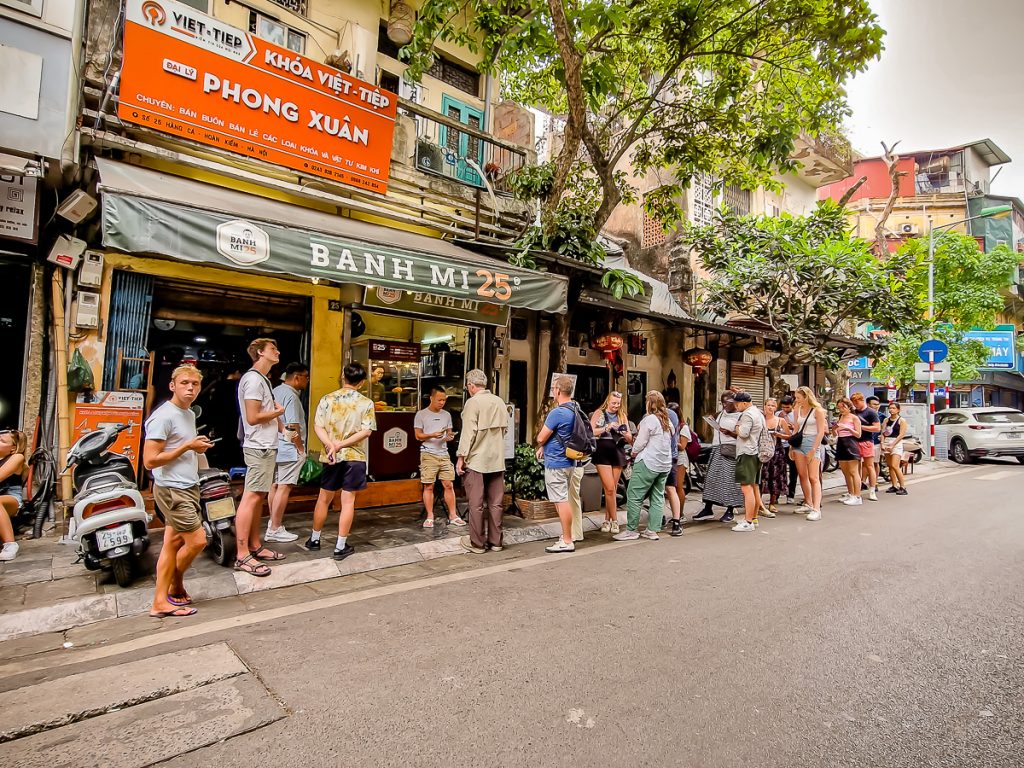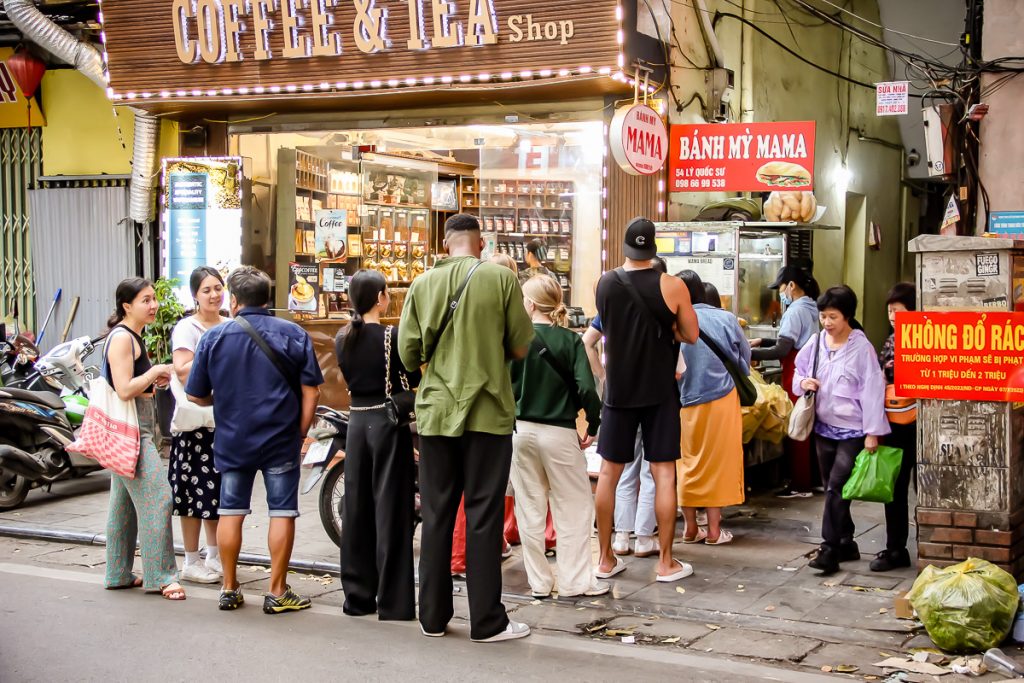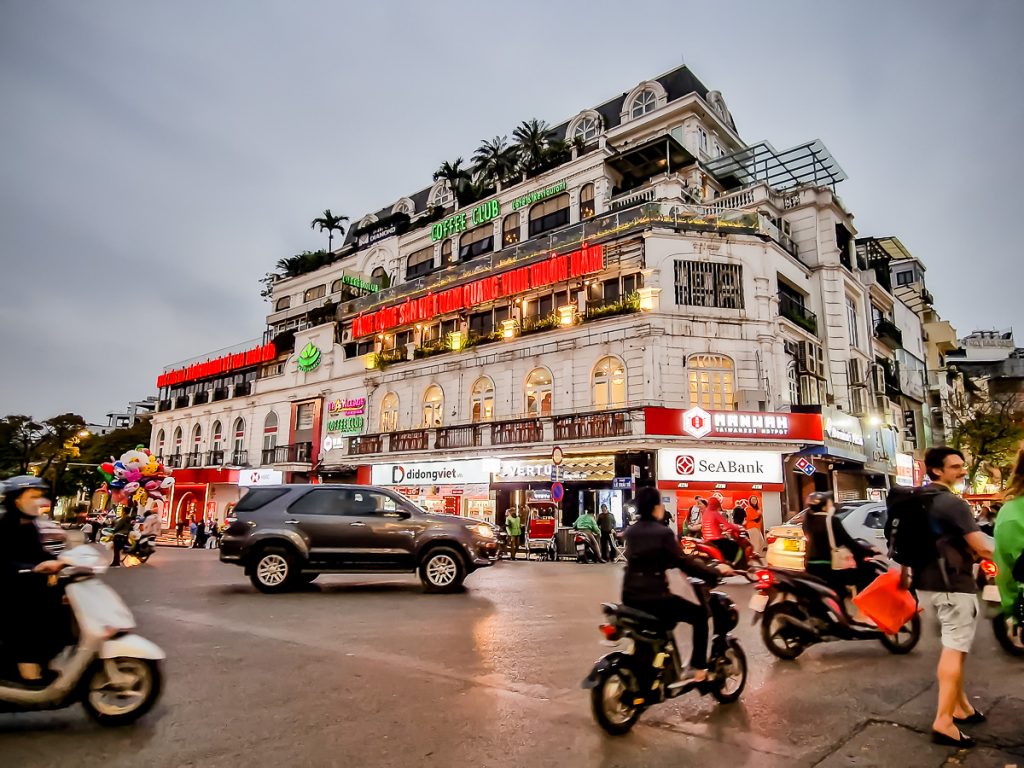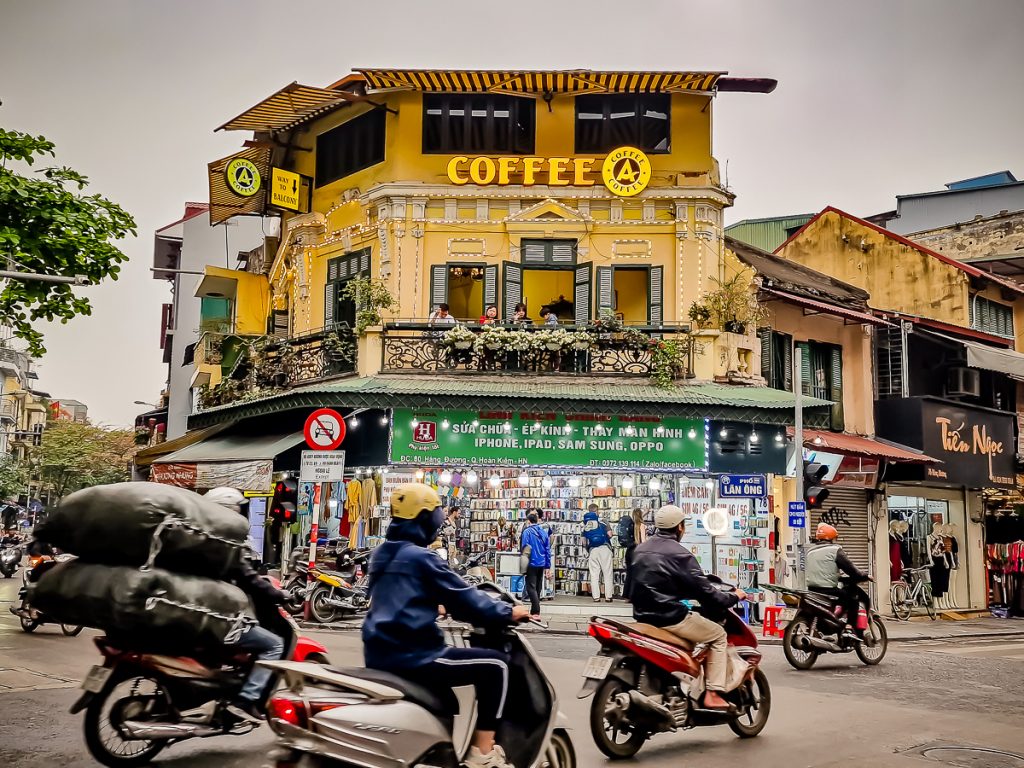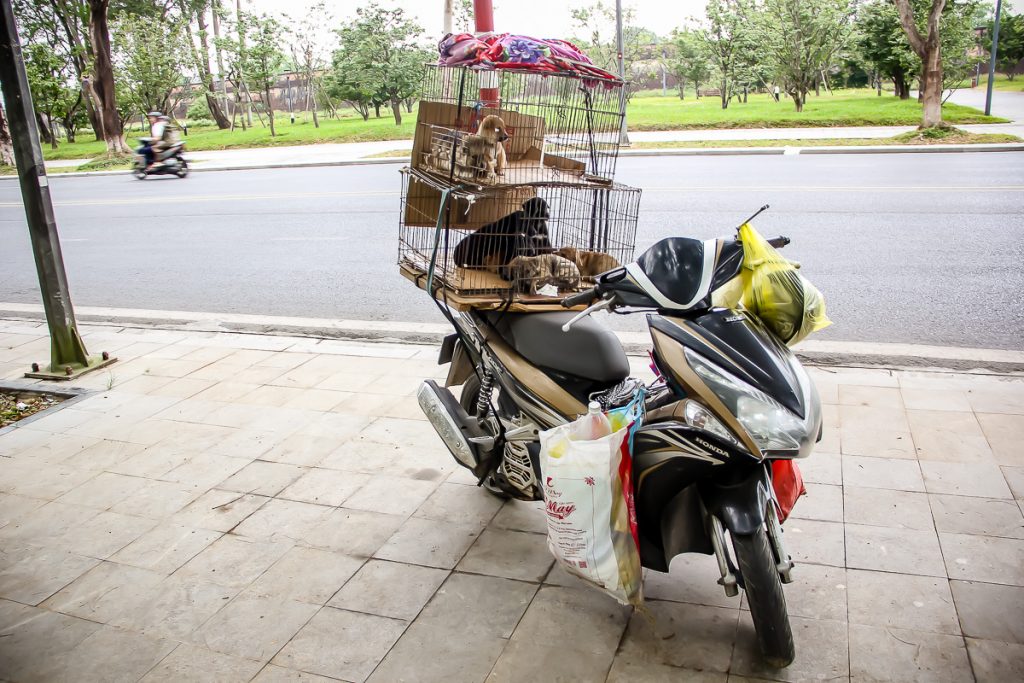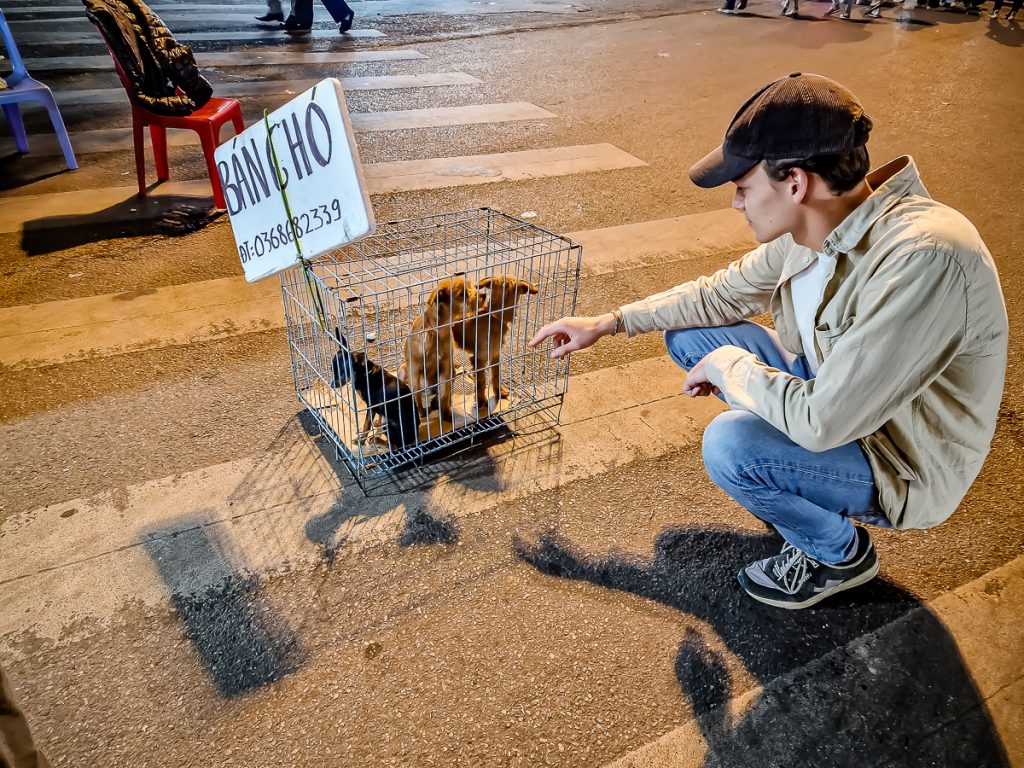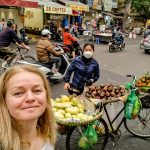A permanent Street Food Festival! That’s how I felt Hanoi, the capital of Vietnam, when I roamed around.
If the overwhelming traffic was the first thing that struck me when I arrived here, the food comes in second!
It’s full, full, full of food everywhere! Cooking is done on the sidewalk, at every street corner, with huge pots placed on what looks like camp stoves!
People eat in small taverns set up in garages or other annexes of houses or directly on the sidewalk, where dozens of tiny plastic chairs are moved and lined up according to how many customers stop at the door.
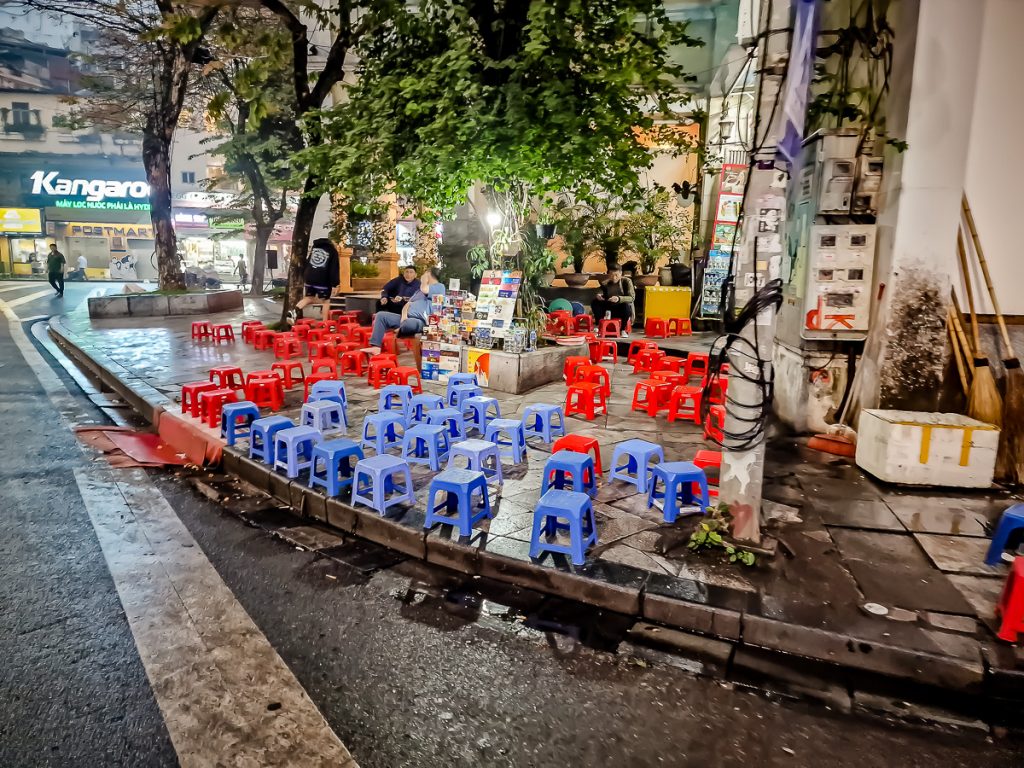
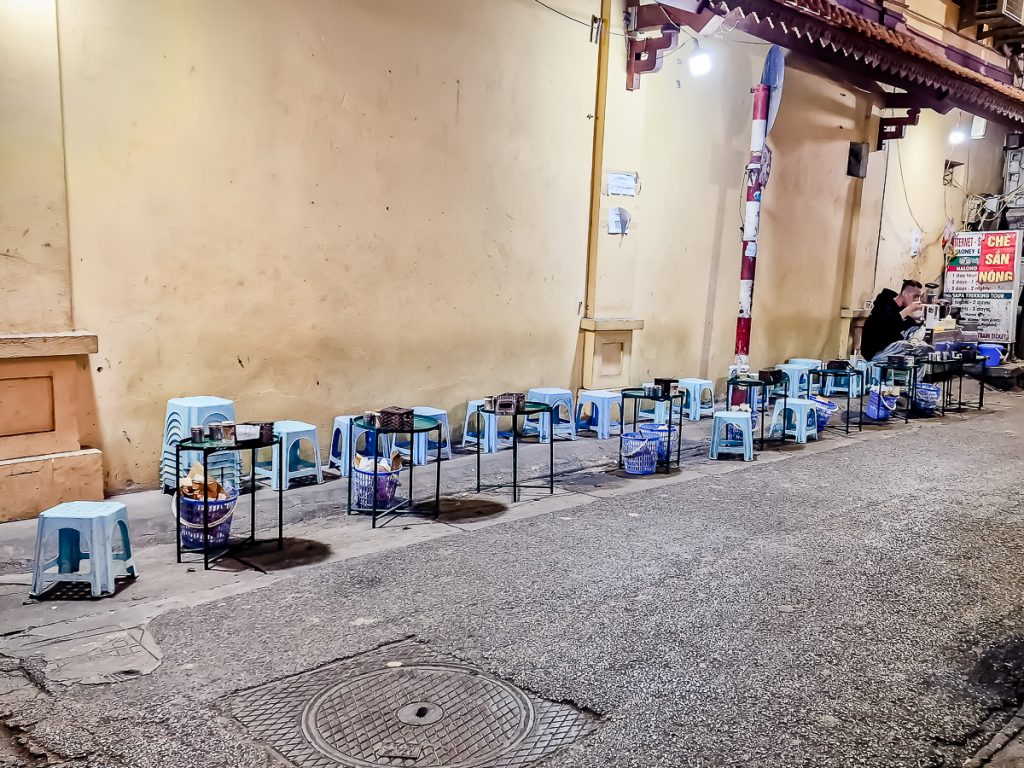
The funniest thing is that the plastic tables and chairs on the sidewalks are illegal 🙂 I can’t imagine how the authorities deal with this, since they’ve taken over all the streets.
Apparently, the police come by for checks around twice in the evening. People gather up the tables and chairs, then… put them back. I, for one, haven’t seen a single policeman, but I’ve seen hundreds of table and chairs.
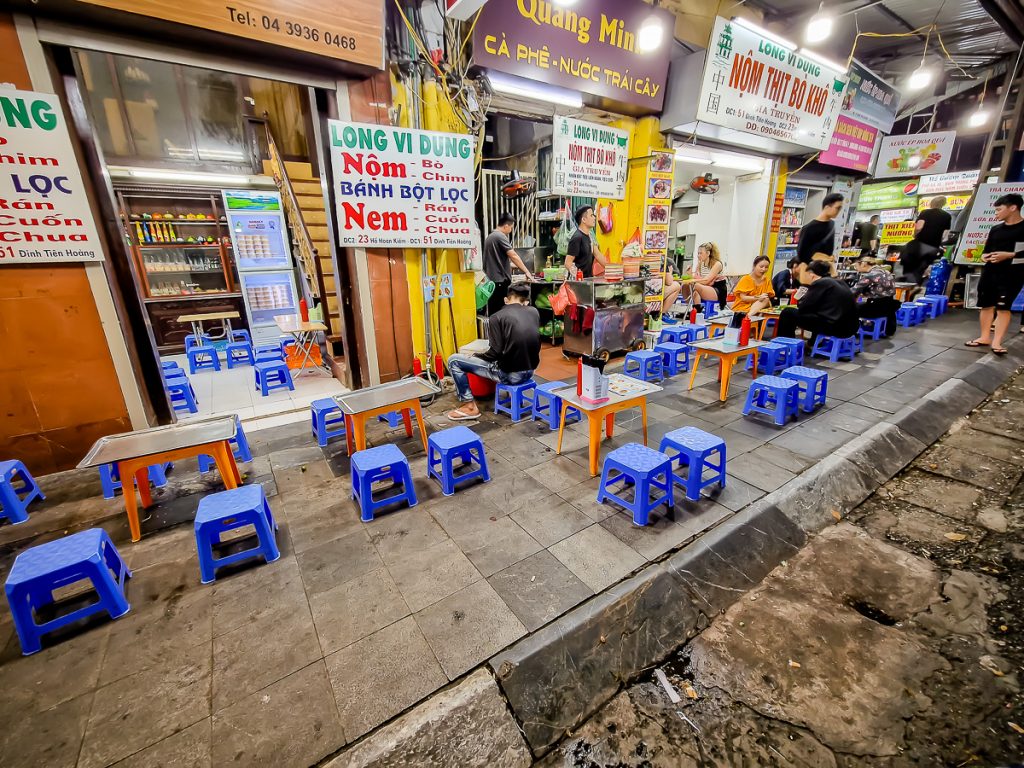
Hanoi seems like a huge public canteen! People are happy because they can grab a meal at any time, anywhere on the street, a wide variety at recognized high quality and very affordable prices! (A main course in Vietnam costs $5-7.)
To quote a local, “Vietnamese eat anything that has four legs, except tables” hahaha. Yes, it’s true, they eat anything from pork, chicken, beef, duck, to dog, cat, rat. I’ll get to the latter in due course…
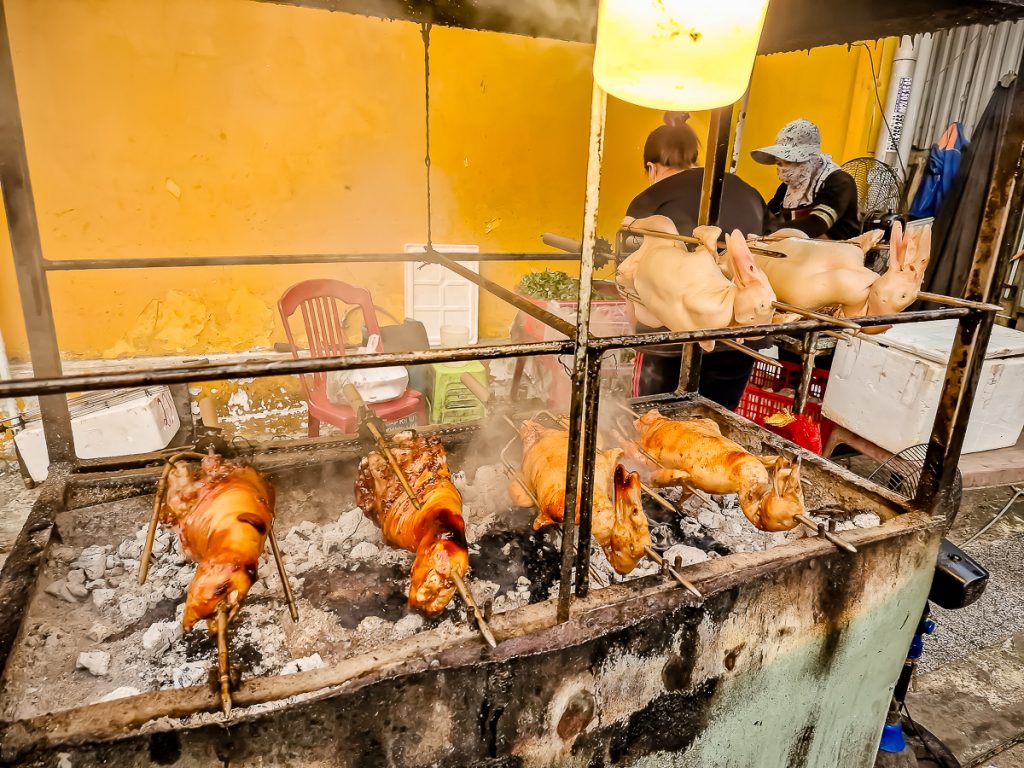
Pork is the cheapest, convenient because they make a lot of dishes from it. Then comes chicken. Followed by beef and duck. Dog is expensive! It’s more expensive than all of these (only beef sometimes surpasses it), as it’s considered a delicacy. Therefore, the fear of going to Asia and being served dog instead of pork or beef shouldn’t exist. No one is foolish enough to serve you one of the most expensive meats on the plate. Instead, you might fear the reverse situation: wanting to eat dog but, in fact, being served pork…
Vietnamese cuisine uses a lot of vegetables and seafood, as these are abundant. Their essential ingredient in their dishes? The greens. I’ve never eaten so many fresh leaves in my life, enough for three years! With everything!
Speaking of “fresh”: Vietnamese buy fresh meat daily, fresh fish, fresh vegetables. It’s their culture to do so, a habit from the times when refrigerators didn’t exist.
Contrary to my suspicions, Vietnamese food is not spicy! Or it can be if you want it to be, as there’s always a bowl of chili slices on the table.
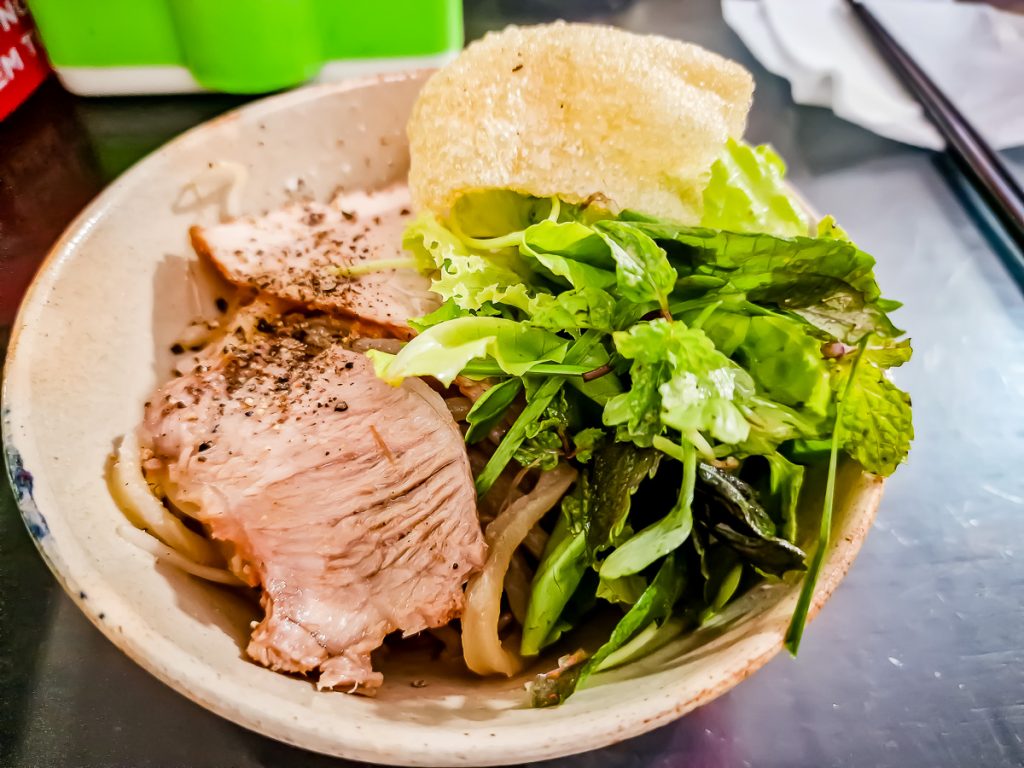
WHAT TO EAT IN VIETNAM?
I’ve heard from others who have visited Vietnam before me that the food is DELICIOUS. Well… I had my doubts, as I’m usually picky. But what do you know? I ended up savoring dishes that I knew little about, but I loved them! I didn’t even want to know what they contained 🙂
I really enjoyed Vietnamese food!
I started, ravenous upon my arrival, with something traditional: PHÓ SOUP.
It’s a soup born right in Hanoi, made with rice noodles, pre-boiled chicken or beef, aromatic herbs (including coriander and mint), and 20 ingredients. You find it everywhere, on every street corner. It’s part of the Vietnamese breakfast, but people practically eat it at any time of day. It’s the most well-known Vietnamese dish in the West, and a very cool thing – it’s even registered in the Oxford dictionary!
I ate it in a place recommended by several locals – 20 Phố Bảo Khánh.
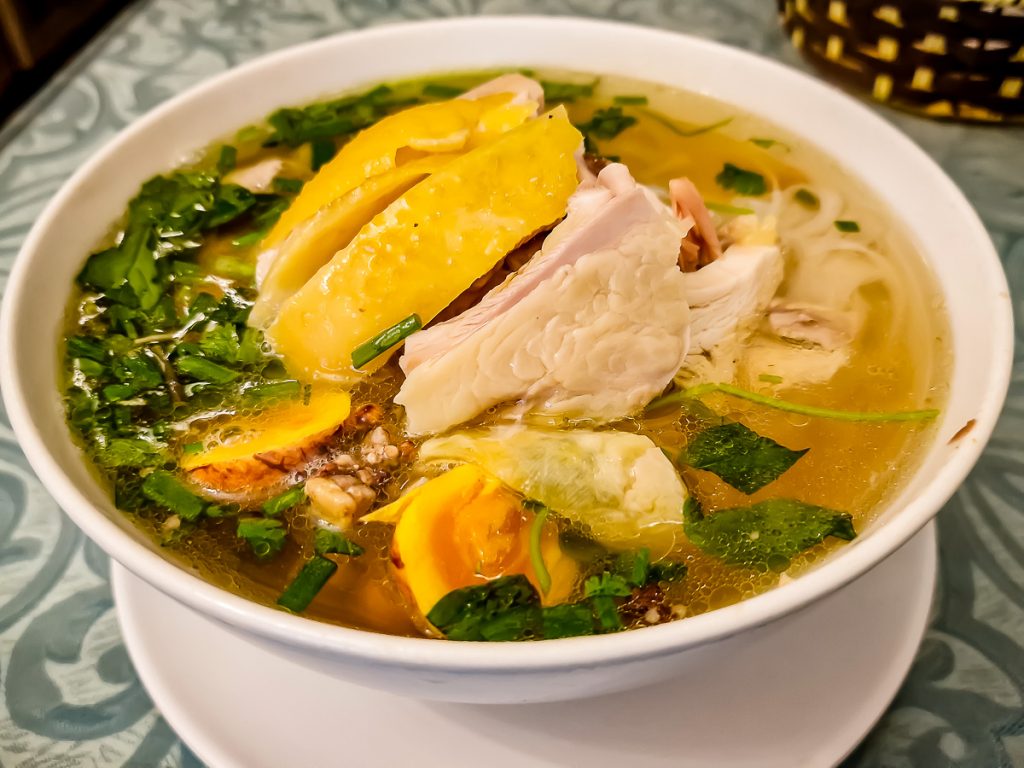
This place is nothing but a bodega that I would have easily passed by on my city wanderings.
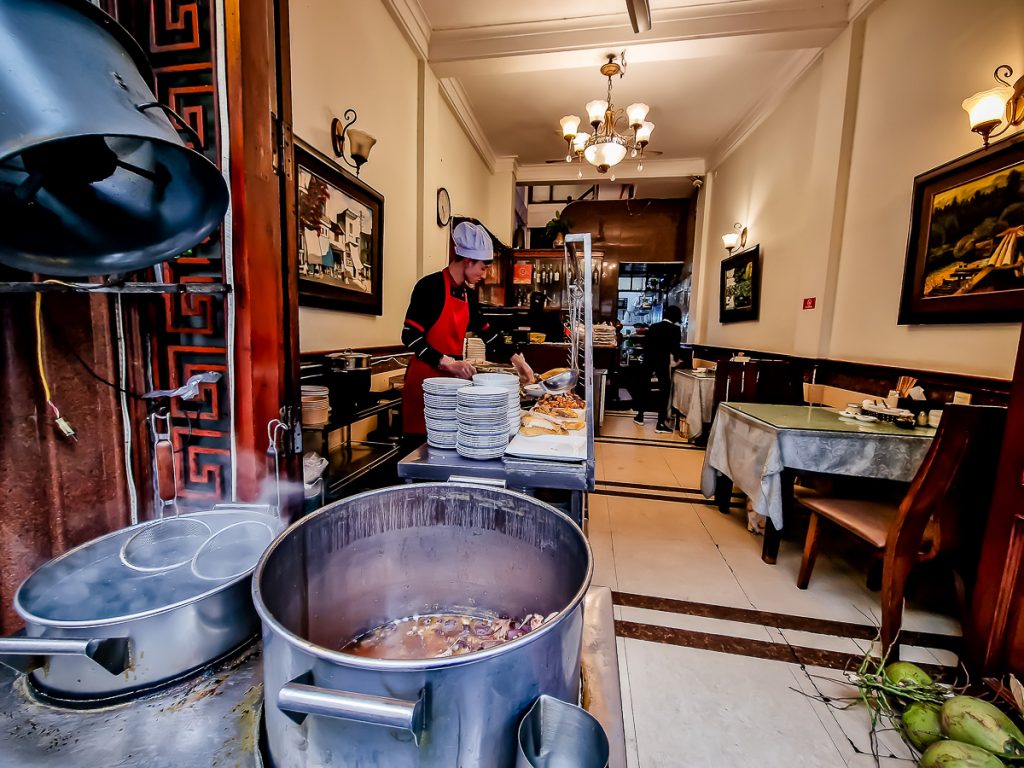
With pots on the street, steaming, with a cook behind the counter, breaking down some chicken, with two tables inside (only later did I see a staircase that probably leads to another dining area upstairs), none of these would have lured me in.
However, the recommendation mattered!
I had the special chicken phó, not just with chicken breast, but also with the thigh, organs (I spotted the liver), egg, and who knows what else. In fact, I don’t even want to know…
I ate at a table with a Vietnamese man. The place’s owner put me there, so I went along… The man slurped the soup and smacked aloud as noisily as possible. I smiled. I remembered that I have read about slurping as a sign of appreciation among the Vietnamese, showing that you like it!
I slurped too, so people wouldn’t think I have something against their soup…
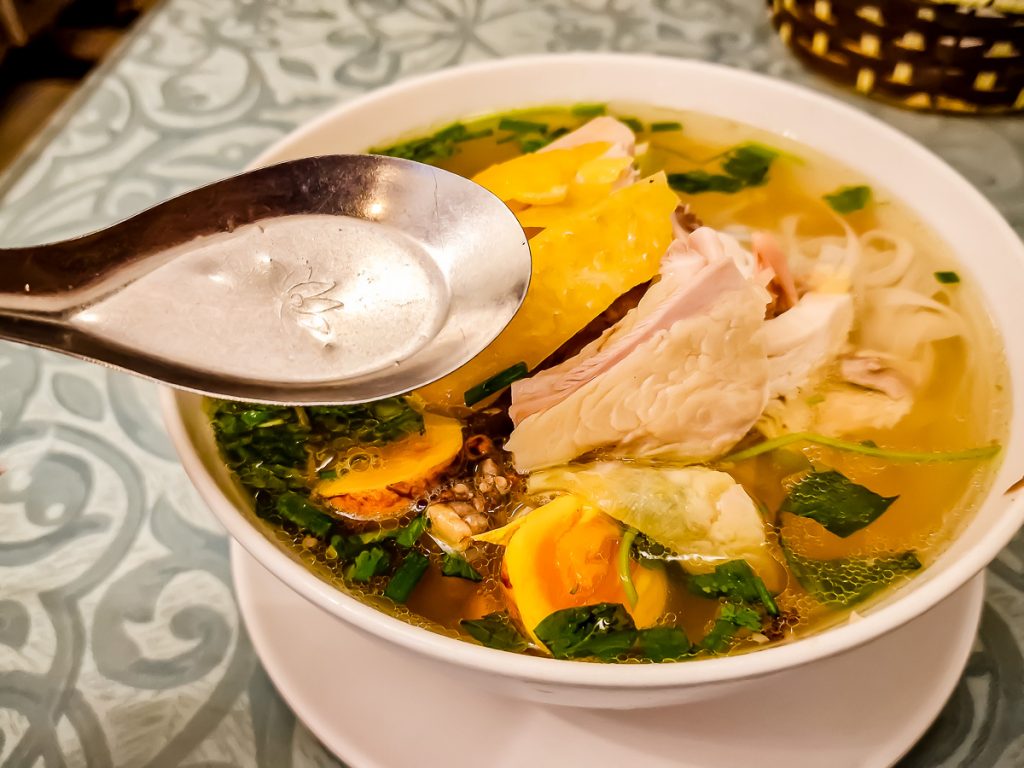
I ate with a metal spoon and two chopsticks, mimicking what I saw the man in front of me doing. I copied his actions, but my pieces kept slipping between the chopsticks…
Thanks for the meal!
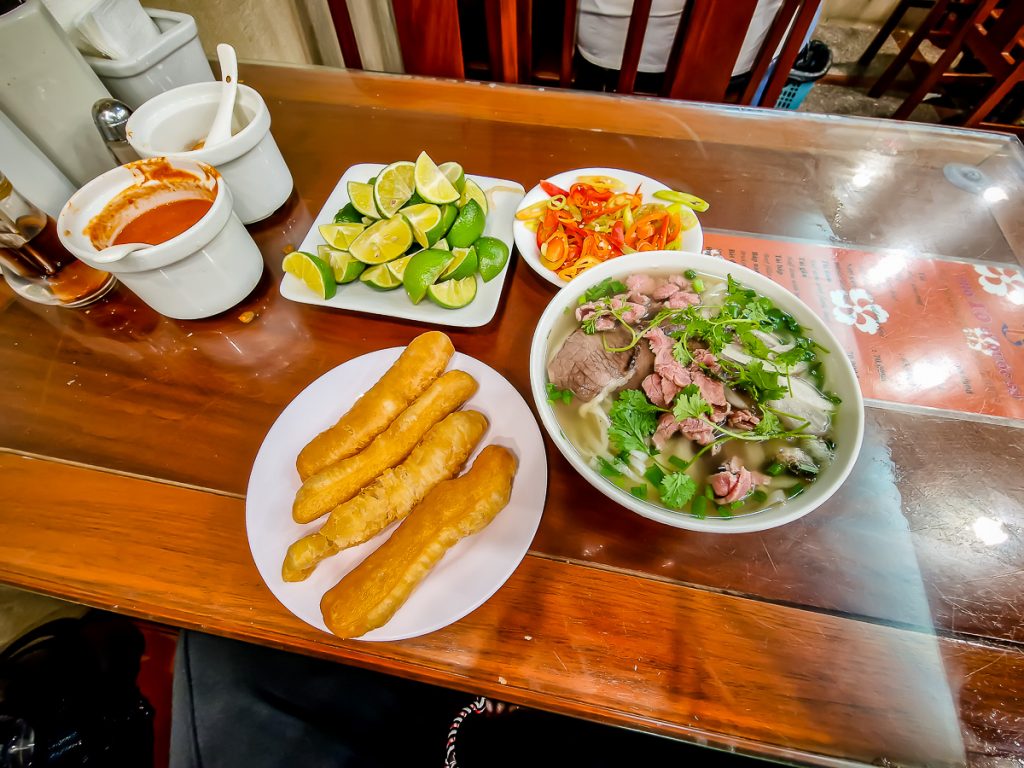
In the following days, I also had beef phó. Again, in a renowned spot recommended by locals – Phở 10 Lý Quốc Sư. Another bodega. Full of people, nevertheless, I was quickly seated at a table with two other tourists, Americans.
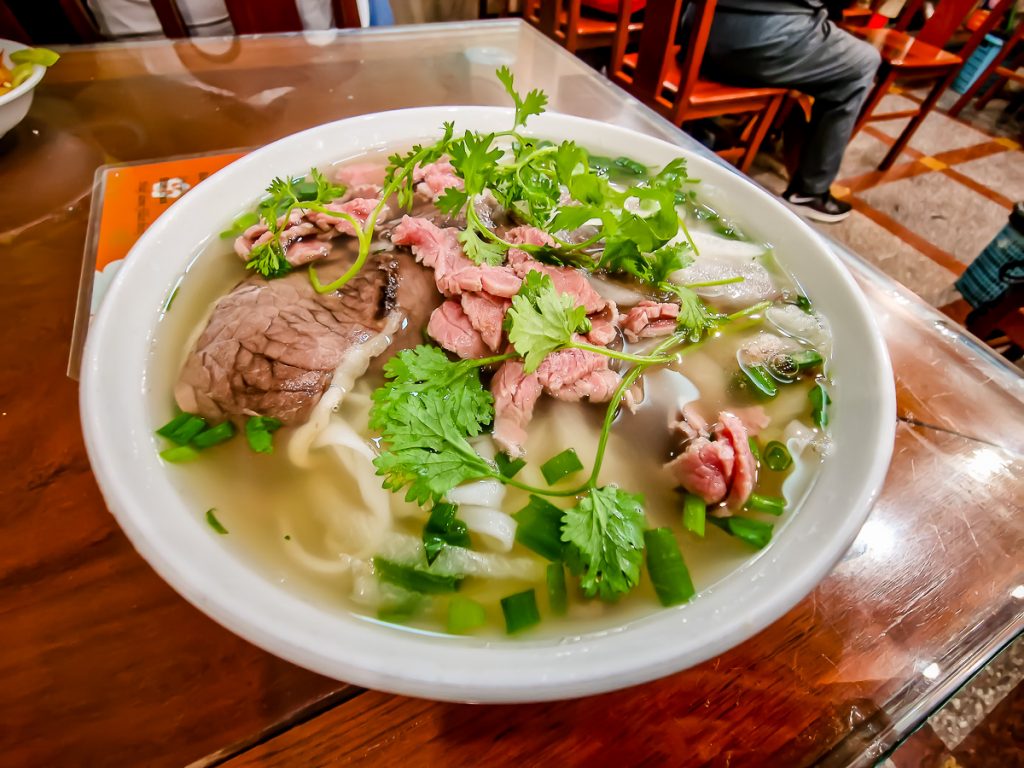
We smiled at each other, cleaned our table corner ourselves, then sipped together from our beef phó. I struggled a bit, as they put a lot of scallion in it, and I fished it out like a Hemingway casting a fishing rod, with great skill. (Note: I really don’t like scallions!)
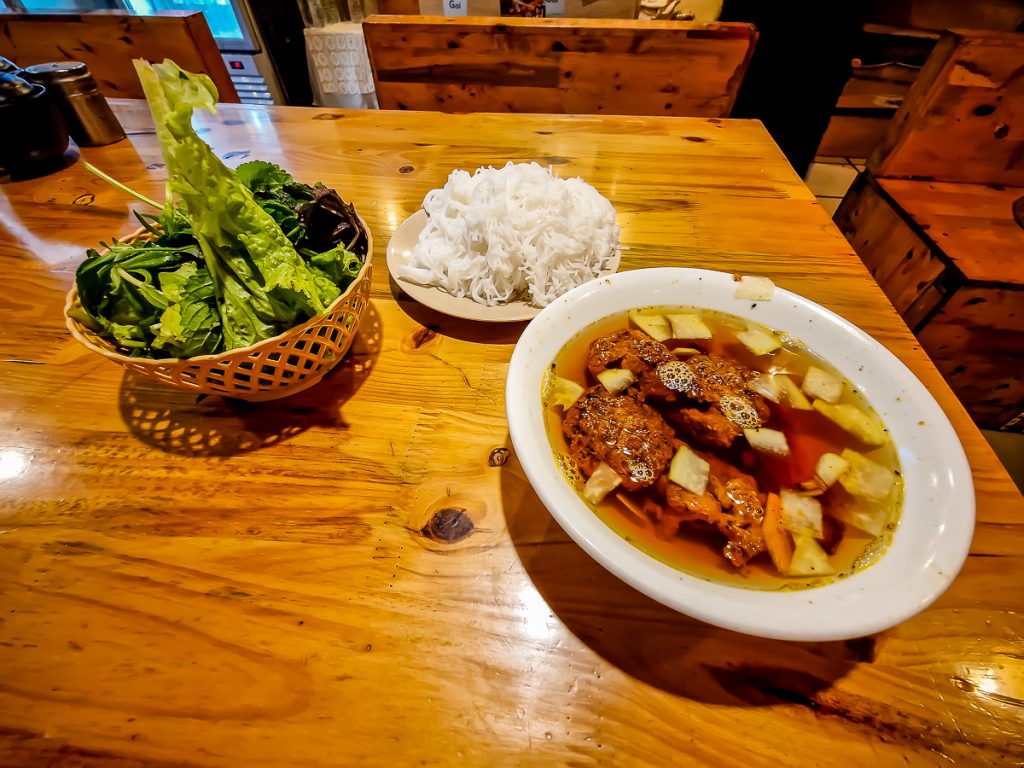
Bun cha is another traditional “soup,” a Hanoi specialty. I also tried this. Of course, in a place renowned for serving the best “bun cha” in town – Bun Cha Ta.
Upstairs is a salon where you take your shoes off before eating. I found out only after I’d eaten downstairs. With my shoes still on. But better: a bit less of a foot smell aids in the normal digestion of those people…
Interesting broth. In it – pork and some very tasty mini burgers. Separately – noodles and aromatic greens, very fresh. I was explained how to eat it: you pick noodles from the bowl they’re in and dunk them in the broth. Then you grab some greens and soak them in the broth as well. Only after that, you take the result from the broth and savor it.
Now, with a point of comparison, I can say that I liked Phó more than Bun Cha. Well, maybe it was the first impression?…
SPICES
Almost everything I ate in Vietnam, no matter where, a few must-haves stood out:
Fish sauce
I read about this sauce, it didn’t inspire much confidence, so I ignored it in the first few days. I regretted it later, when I discovered that, indeed, it’s excellent with many of the dishes served.
It’s a sauce made from anchovies, garlic, and chili. Very good, especially when dipping spring rolls in it. (The one on the left also has papaya.)
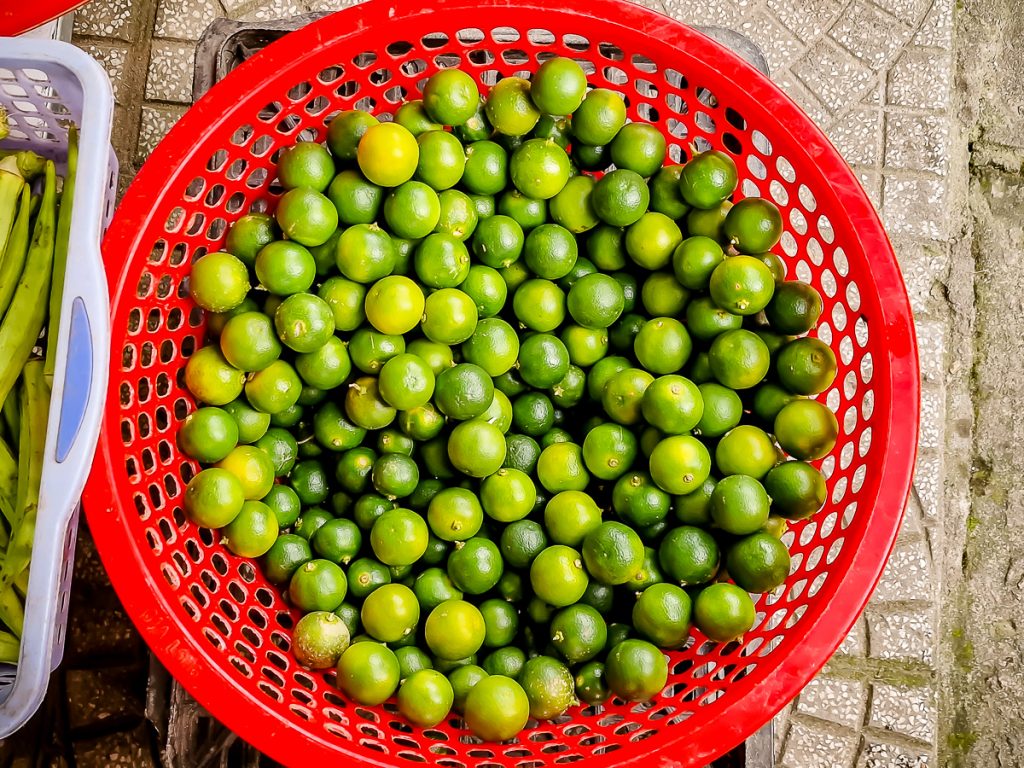
Baby limes are always on the table. A smaller lemon than the limes we know.
You either have a bowl full of slices, or you have a piece next to coarse salt and pepper.
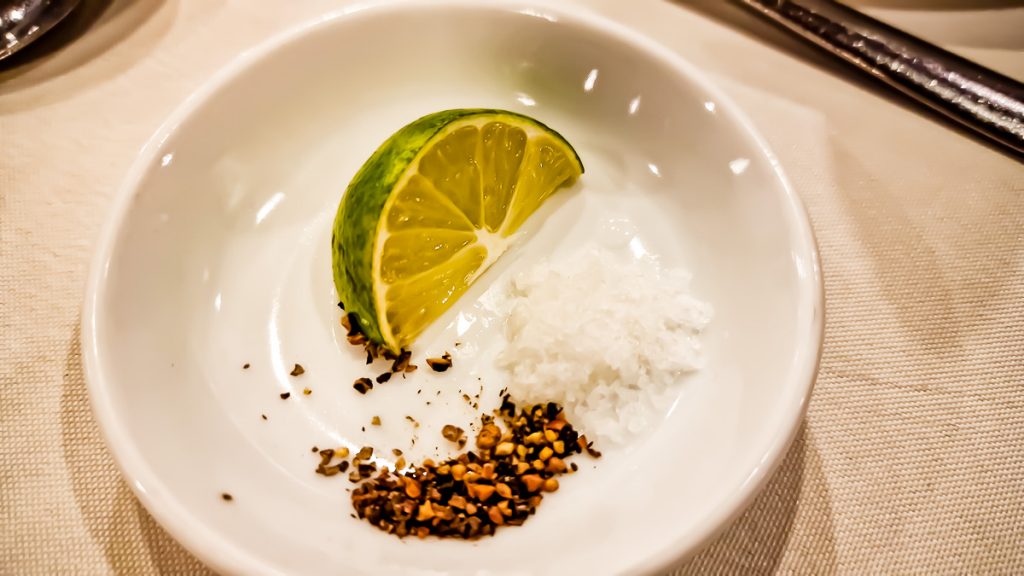
I learned to make the simplest and quickest sauce: squeeze lime over salt and pepper, mix them, then coat the meat with it or pour it into a soup. Good!
And I learned something from a Vietnamese: after squeezing the baby lime, you take the chopsticks from the pile on the table and wipe them off with the remaining lime juice… Even if they’re washed (because they’re not disposable), it’s safer to “clean” them with a little lime juice too.
FOOD TOUR IN HANOI
Initially, I wasn’t tempted to go on a food tour, given that I had already eaten enough on recommendations. But I thought it wouldn’t hurt to be “guided” by a local through the city full of eateries that I likely wouldn’t have ventured into alone. Besides, I was hungry, nearing dinnertime…
So, I paid $25 and joined the group on a 3-hour culinary tour. I invite you to salivate… uh, I mean, to savor.
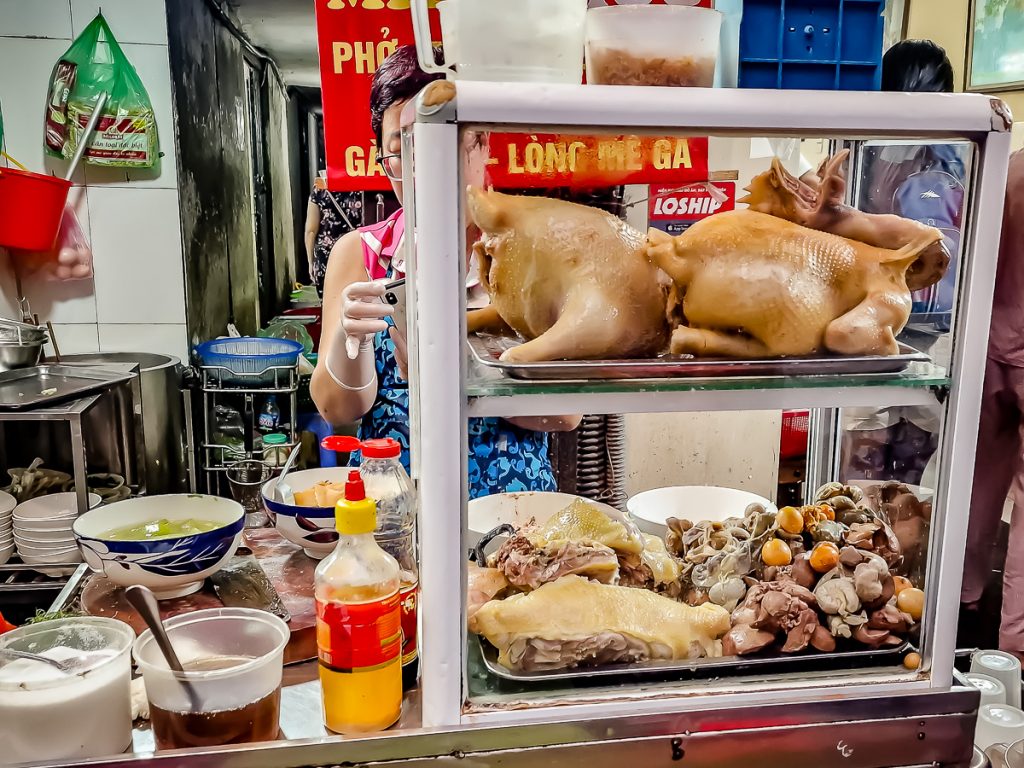
After a walk through traffic (where else?…), the first stop is in a sort of garage, where Phó is served. Chicken phó.
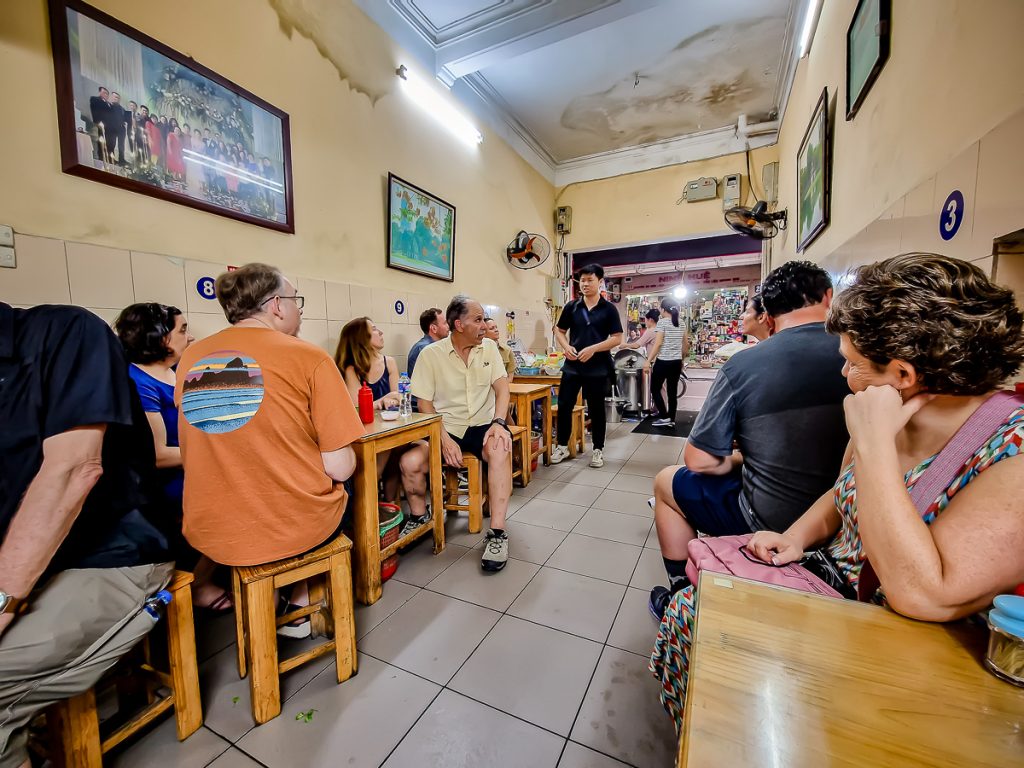
It smells good, and our guide tells us that’s the sign to confidently enter such a street eatery, no matter how bad it looks: if it smells good, it tastes good!
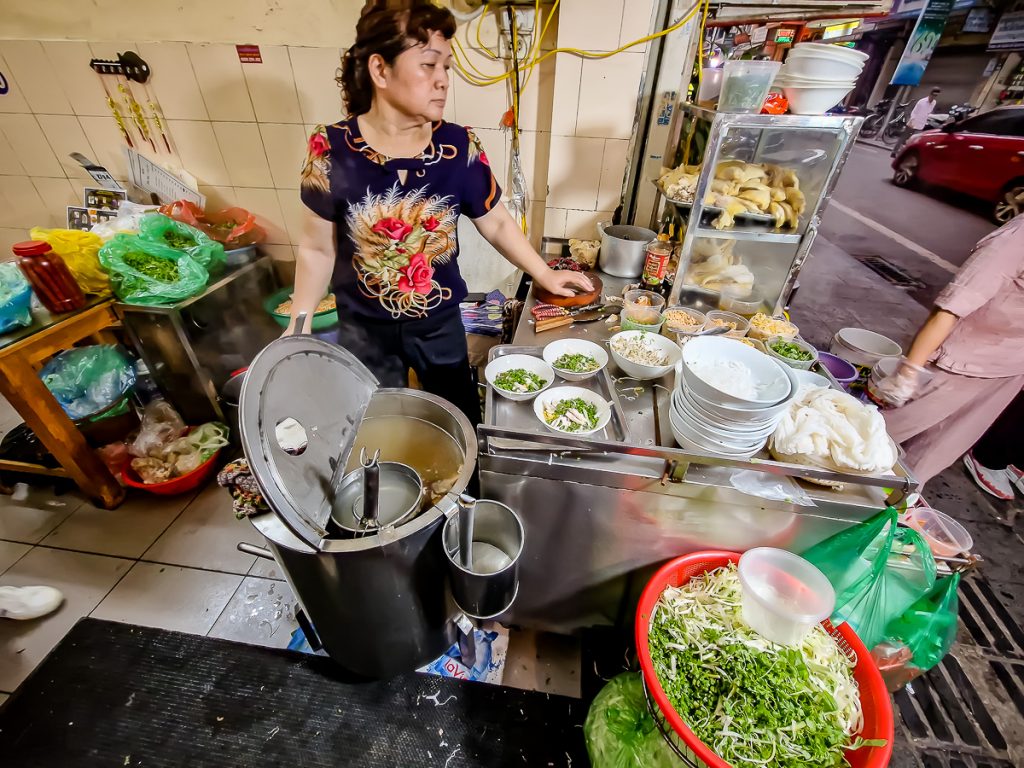
The people here wake up at 4 am every day, slaughter 10 chickens, and then prepare phó. For Vietnamese, for foreigners, it doesn’t matter.
I have a question about what I read online and, until the soup arrived, the guide clarified it for me: it’s not good to place the chopsticks in a “V” shape or insert them into the rice in a “V” shape. It’s a symbol of death. When you’re done, the chopsticks should be placed side by side over the bowl.
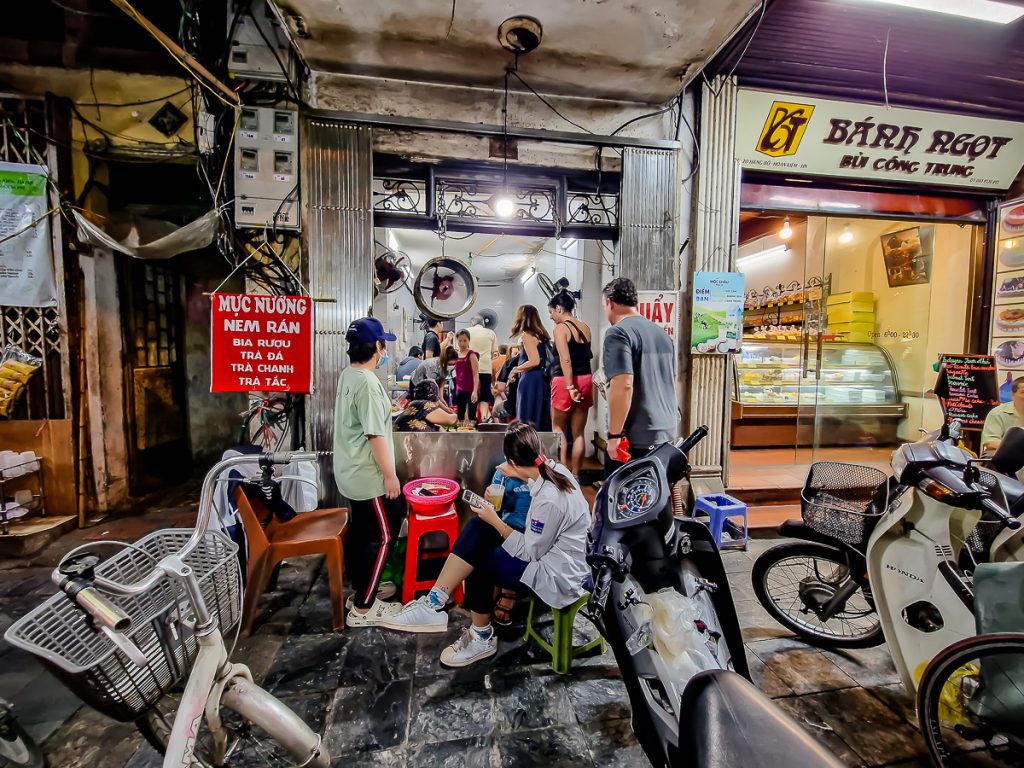
The next stop is in a kind of… warehouse. We all gather around a few tables, on small kindergarten-like chairs.
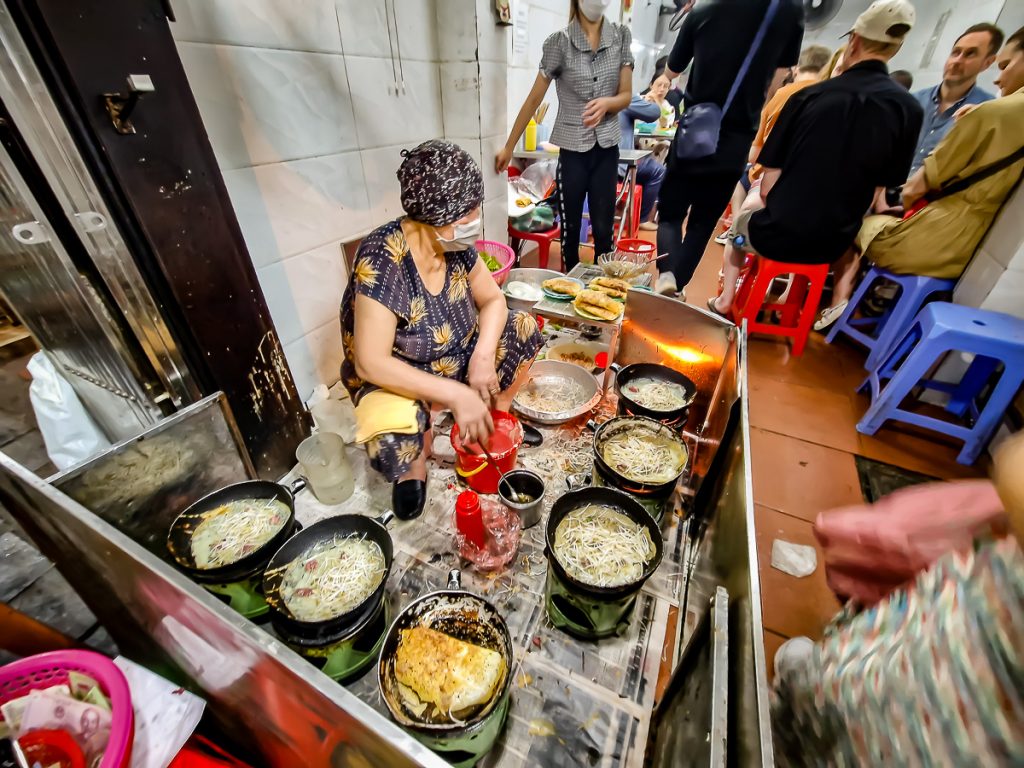
At the entrance, half outside, half inside, a 70-year-old woman has her kitchen set up on the floor!
It is infernally hot in her area, as multiple burners are lit, on which the lady continuously prepares a dish. She cooks beef spring rolls. She’s been making these for 30 years!!!
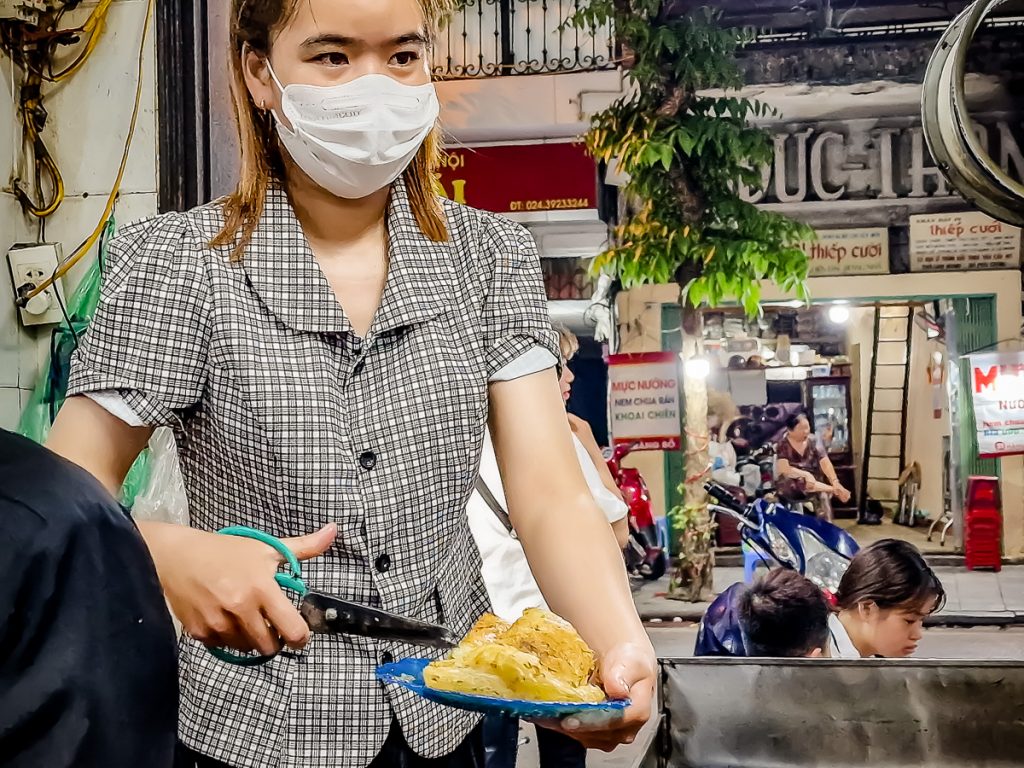
We are amazed, we admire her, and then panic, as we learn we have to make our own spring rolls, or no food for us, huh!
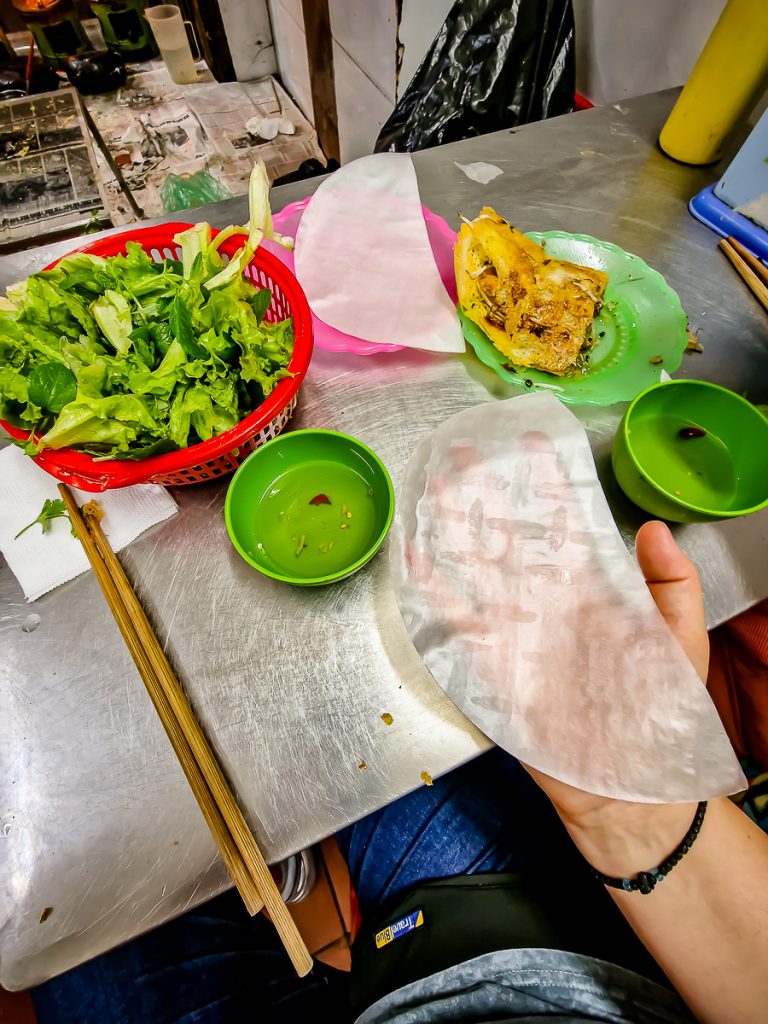
We receive instructions, and everyone does their best. To be honest, I ate the ingredients more spilled than wrapped…
Over the next days, in different places in Hanoi, I saw queues at stalls or small restaurants. Surprisingly, most queuing were tourists.
“They’re waiting for Banh mi“, I find out. And on our food tour, I discover what it is:
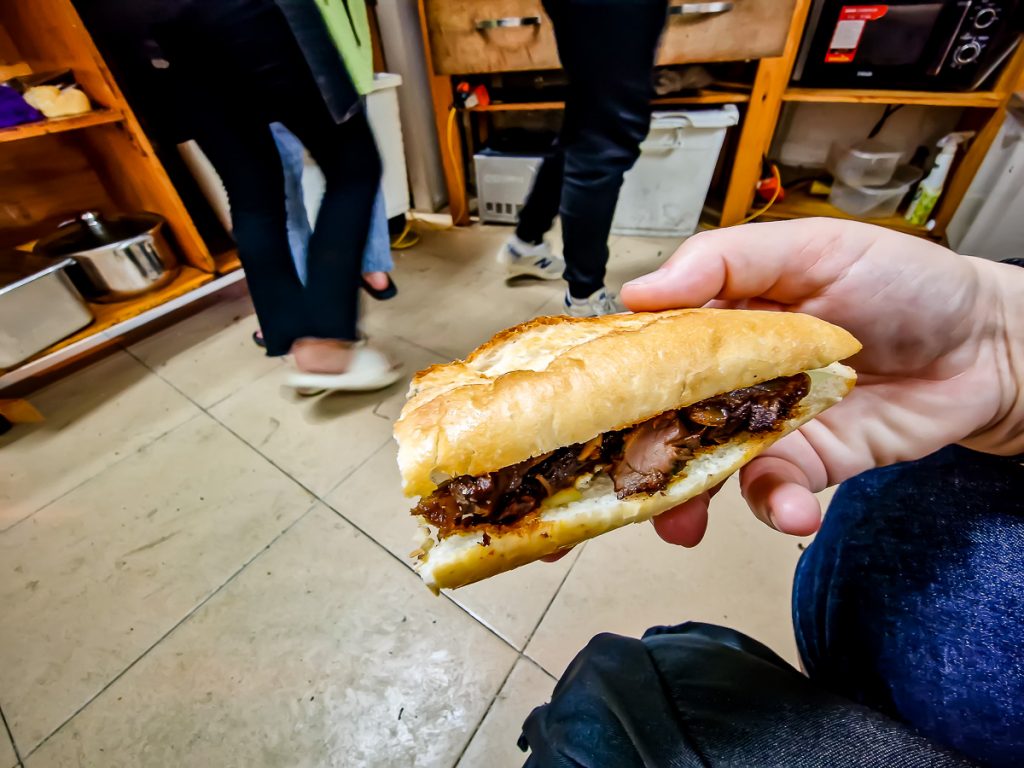
Sandwich with pork, liver pâté, green salad, carrot and papaya salad. It’s extremely popular in Vietnam, and I realize that it’s the only dish that comes with bread! Seriously, throughout the vacation, I had bread only at the hotel breakfast, otherwise, you don’t get bread with anything else.
Banh Mi is cheap. It was included in the tour cost, but I had it at other places in Vietnam and paid 15,000 dong for one, which is 2.94 lei (a little over half a euro).
If you don’t like liver pâté in the combination, you can request it without. Or there are sandwiches on the menu without it from the start.
“As the dog is the man’s best friend, Banh Mi is the Vietnamese’s friend”, our guide tells me to underline the sandwich’s popularity. Immediately after hearing “dog”, I began to ask questions haha… I’m gonna tell you what I heard.
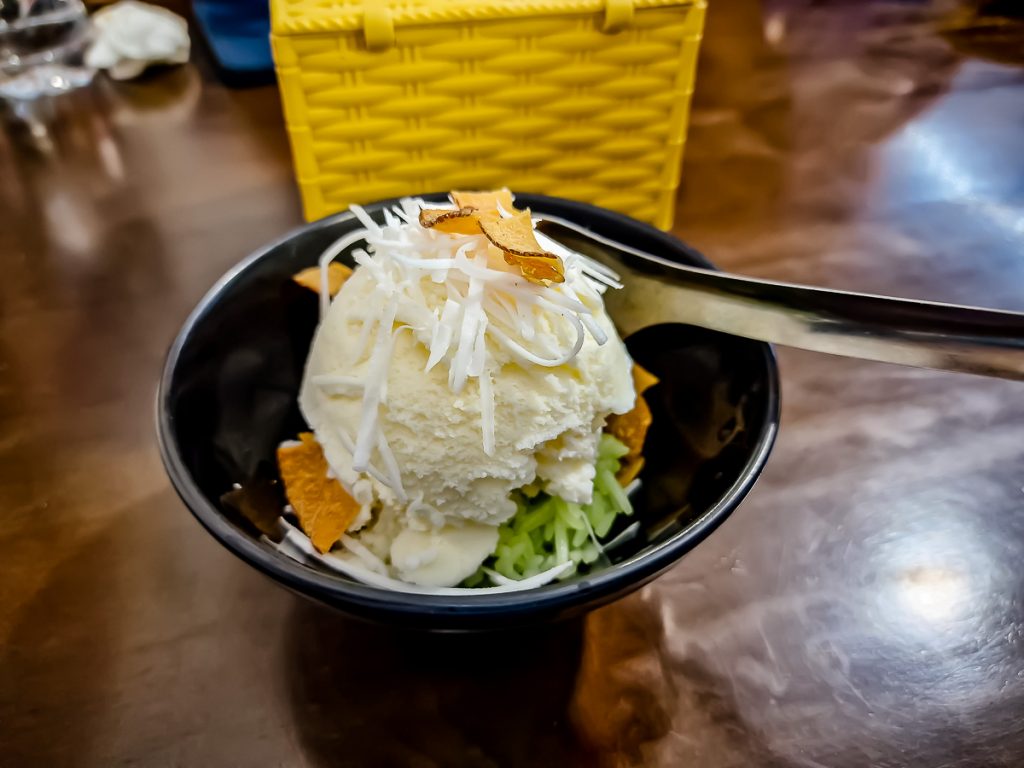
A dessert followed, quite rare here, as the Vietnamese rarely excel in desserts. They lack training. Well, how can you bother making dessert when you have such a bounty of fruit that I, personally, envy!?
We stopped at a spot labeled Dessert Shop, a sign that someone is trying to corrupt the Vietnamese into eating cakes and ice cream and leave the fruit 🙂
We were served sticky rice with ice cream. It’s a sort of rice pudding, but without milk. And the rice is much denser, and, attention, it’s green!!! (visible at the bottom of the bowl).
Why green though?? Well, from certain leaves that sweeten it. This way, they don’t add sugar or milk. Pretty smart, don’t you think?
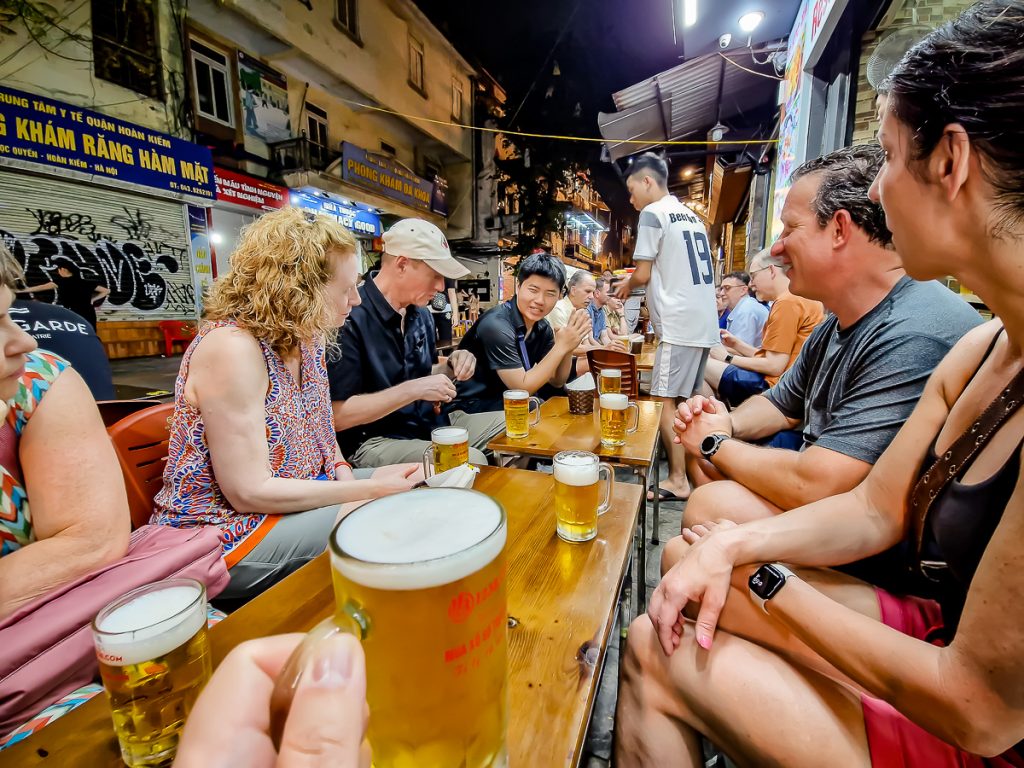
Although I thought that the dessert was the end of our food tour, that wasn’t. Beer came next! Because beer after ice cream it’s a dream 🙂
Before clinking glasses on the famous Beer Street (about which I’ll talk in a future post), I noticed something: as we advance in our tour, the chairs become more and more smaller hahaha. And I learned something: showing respect to a person also comes from simply tapping glasses with him/her. A young person toasting an older one or a subordinate to a boss will always hit the glass below the one they’re showing respect to. I watched the young guide with us do the same, precisely a bit lower.
And, since we were out for a drink, I asked what his favorite… food is. “All the food in Hanoi”, he replied, reminding me what I had learned a few days earlier: food from northern Vietnam differs from food in the south. Phó eaten in Hanoi tastes different from Phó in Saigon.
If you go to a Vietnamese restaurant in America, for instance, the food will be like that in southern Vietnam. The explanation? Most Vietnamese who fled from the war to the wide world are from the south. So they cook the way they did at home.
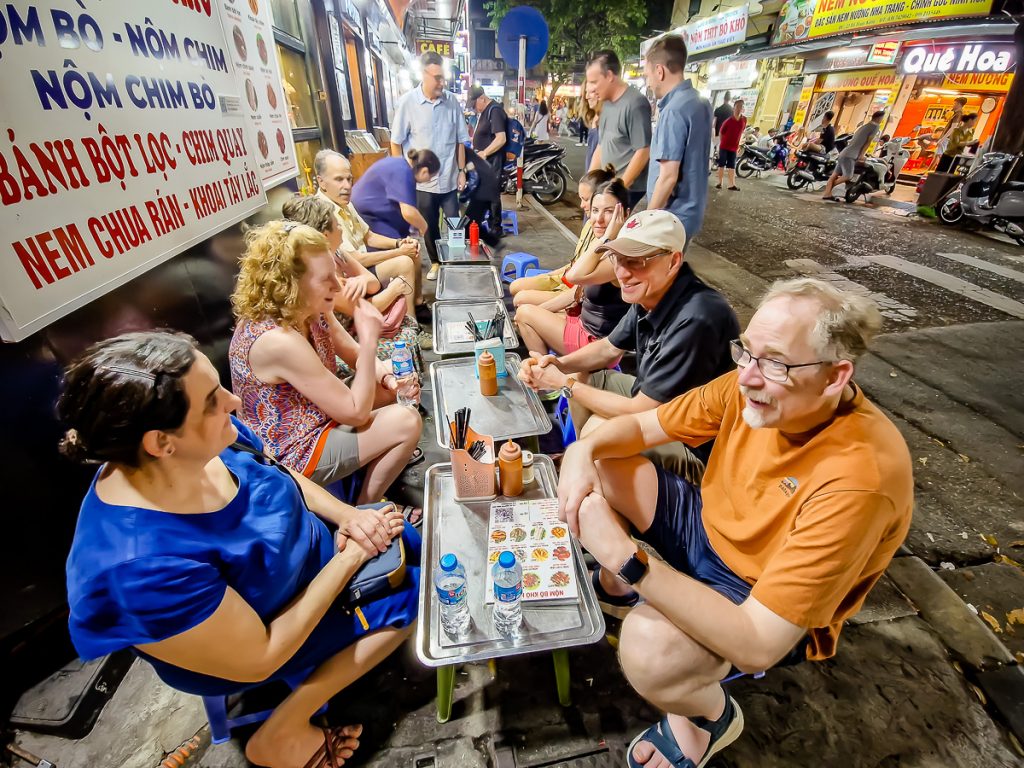
We continue savoring dishes with a northern taste… Because yes, we keep eating, what do you think?? But with increasing difficulty. Not just because we are stuffed after everything we had eaten so far, but also as, incredibly true, at the next stop, we sit on even smaller chairs than before, with our knees in the mouth and our bellies contorted.
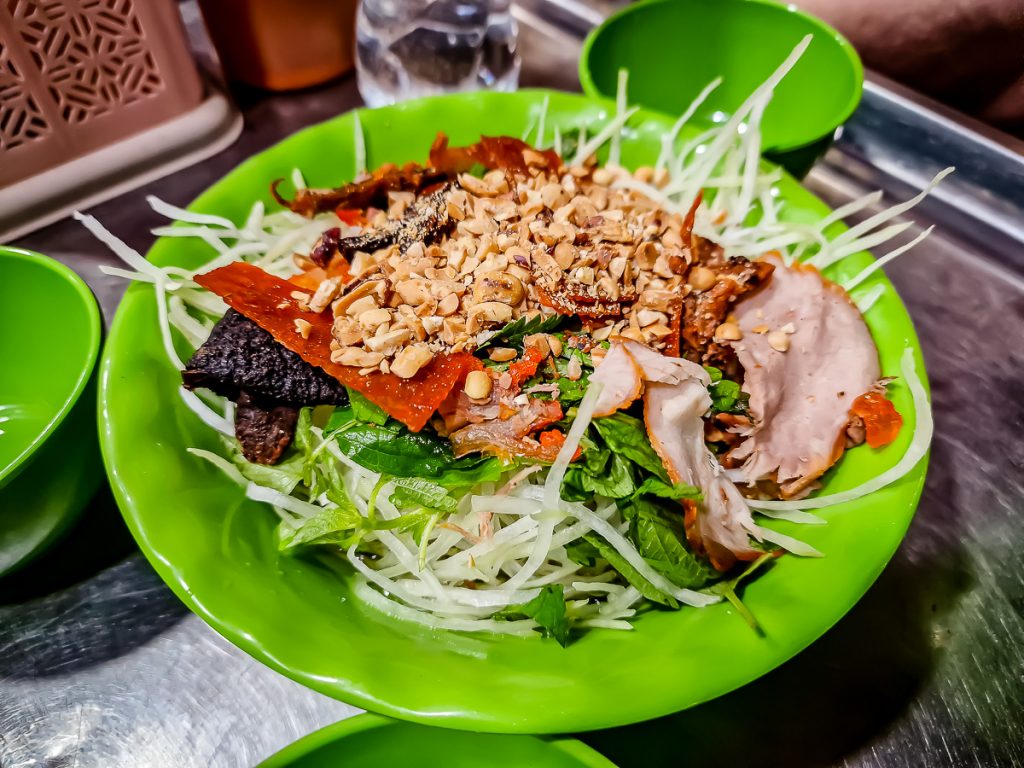
I ate dried beef with papaya salad. And with other things too… Such as peanuts, generously added. I noticed that Vietnamese people use peanuts a lot in salads or as a “seasoning” to complement their sticky rice rolls.
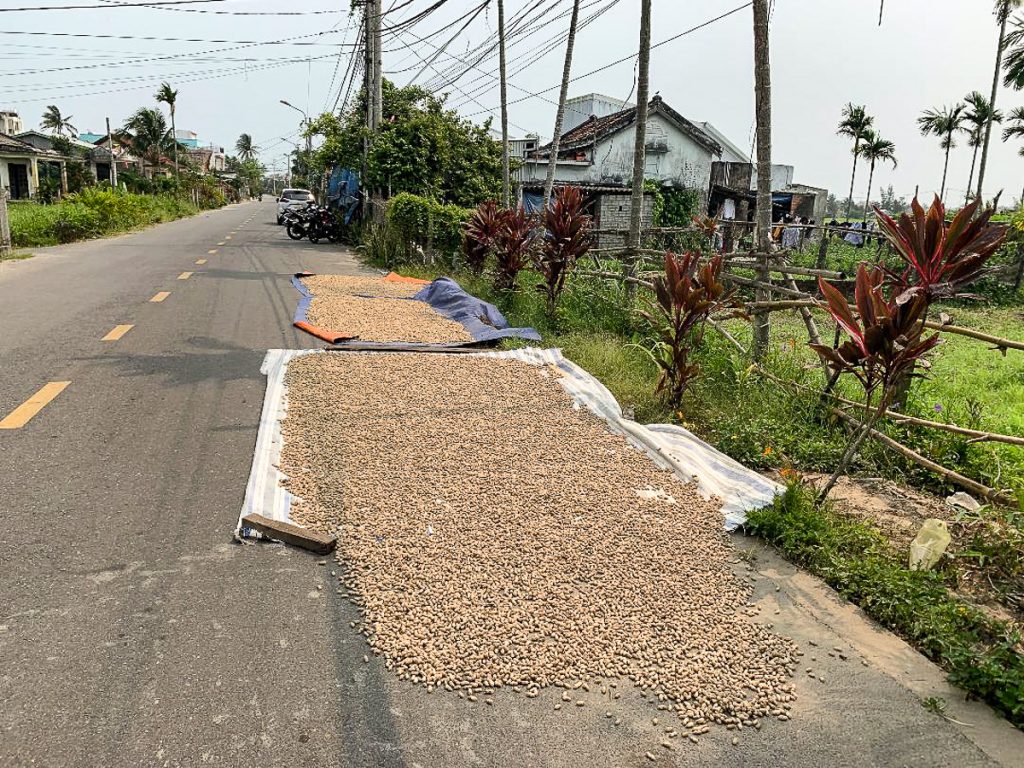
During our travels, we saw how these people stretch large sheets directly on the road, sheets on which they leave peanuts to dry. Or to tan… Naturally roasted.
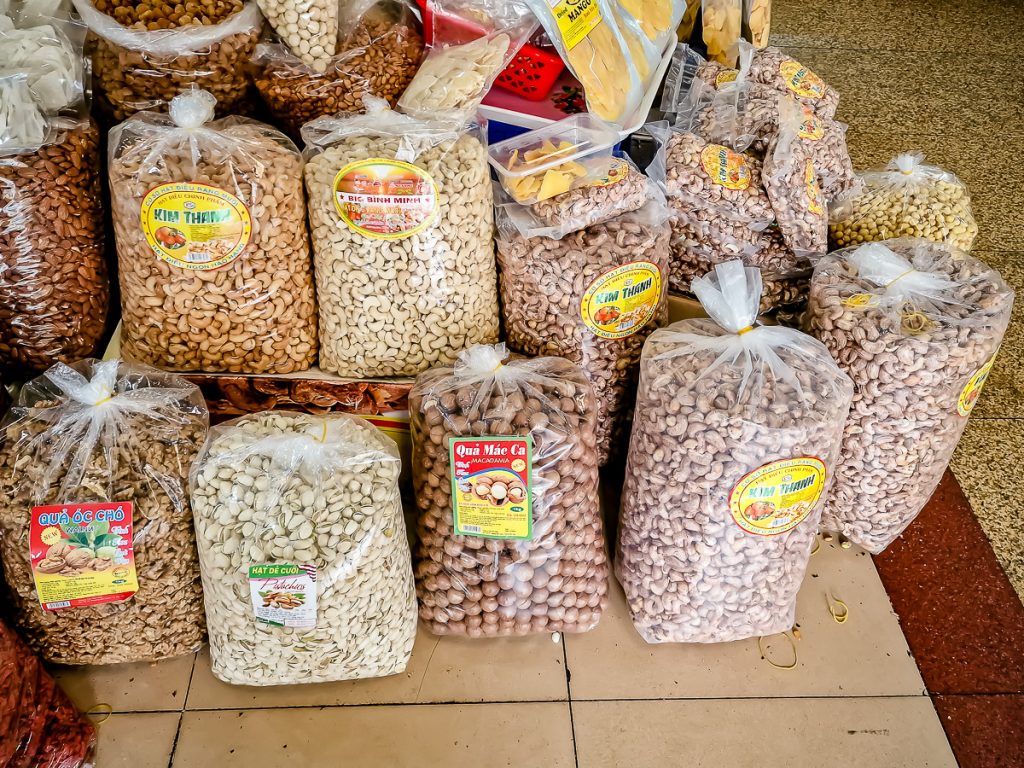
Anyway, you can find abundantly all kinds of dried fruits, seeds, etc. You can buy them with a wheelbarrow!
And we arrive at the final stop of our food tour: a traditional coffee shop, where we will drink egg coffee!
But I have to tell you a bit before inviting you to “egg coffee”.
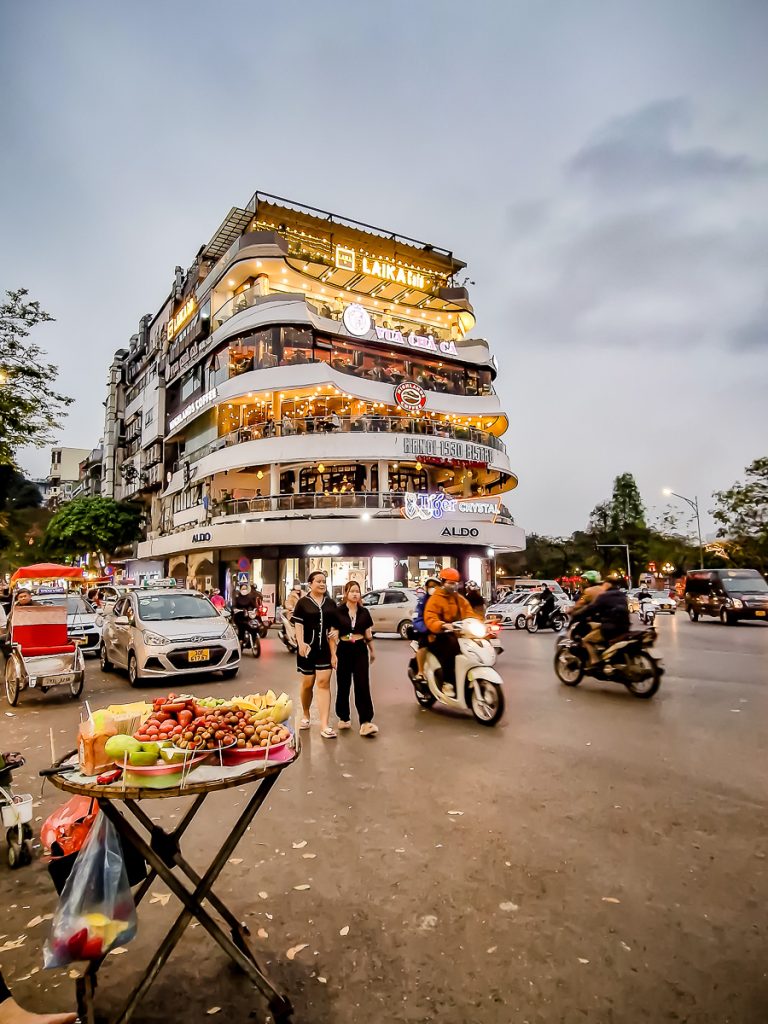
CAFÉS IN HANOI
I don’t drink coffee, I’ve never drunk it, so my first visit to a coffee shop in Vietnam ended up with a “lemon tea” haha.
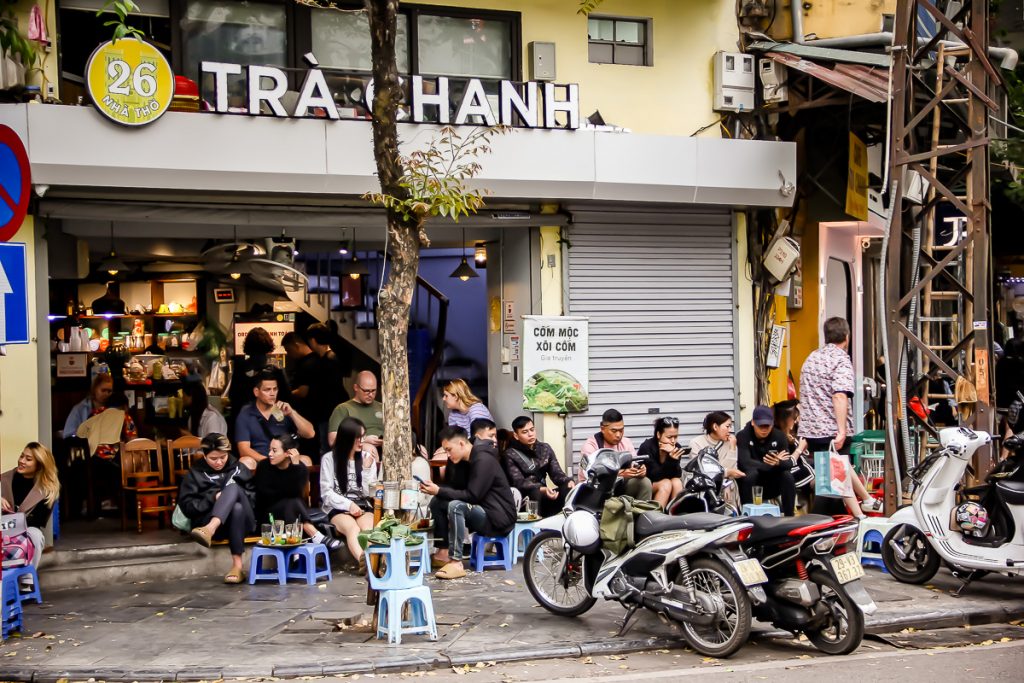
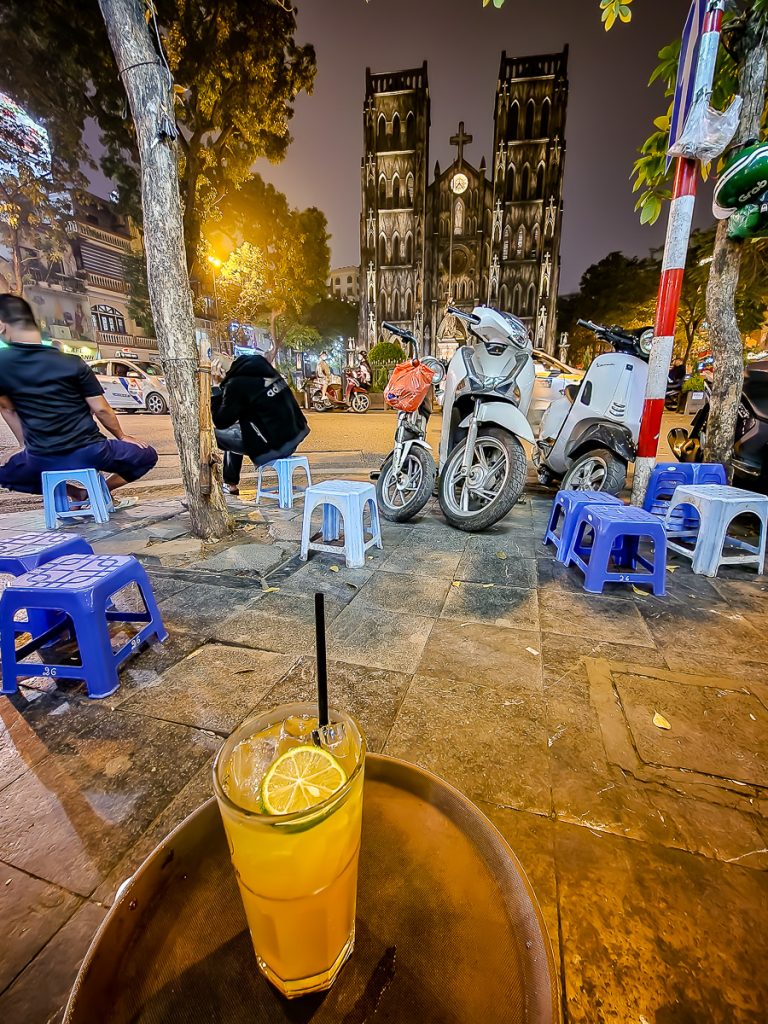
I don’t drink tea either (for me, tea remained a “flu drink”), but I was influenced by a recommendation I found online, that you can’t miss having a lemon tea in front of Hanoi Cathedral while watching the traffic. So I complied.
Then I started to learn more about Vietnamese people and coffee: did you know that Vietnam holds the 2nd place in the world for coffee export, after Brazil?!? I wouldn’t have guessed that even in 100 tries!
And this is thanks to the French. It’s one of the good things they admit about the French occupation. (I’ll write about others in a future “episode”.)
I can almost see the French, tired after they invaded Vietnam, with their suitcases still unpacked, wondering, “well, well, where’s our coffee??”
And there came coffee to Vietnam. First just like “let’s have a coffee”, then “let’s have a coffee shop”, ending now as among the trendiest in the world!
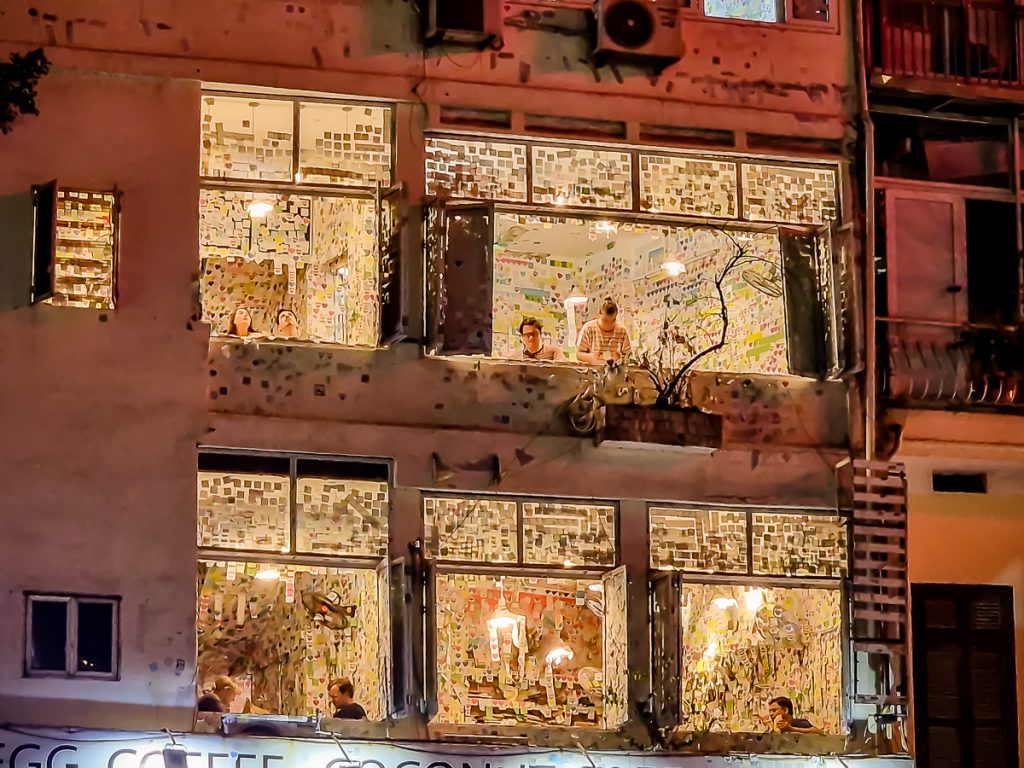
EGG COFFEE
For coffee lovers, Vietnam is a perfect place! But no matter how well you know the types of coffee from around the world, once you’re here, you must taste “egg coffee”. Even I, who don’t drink coffee, tasted it…
And I said that if I’m already recording a premiere, let’s do it in a famous café in Hanoi: Café Giang.
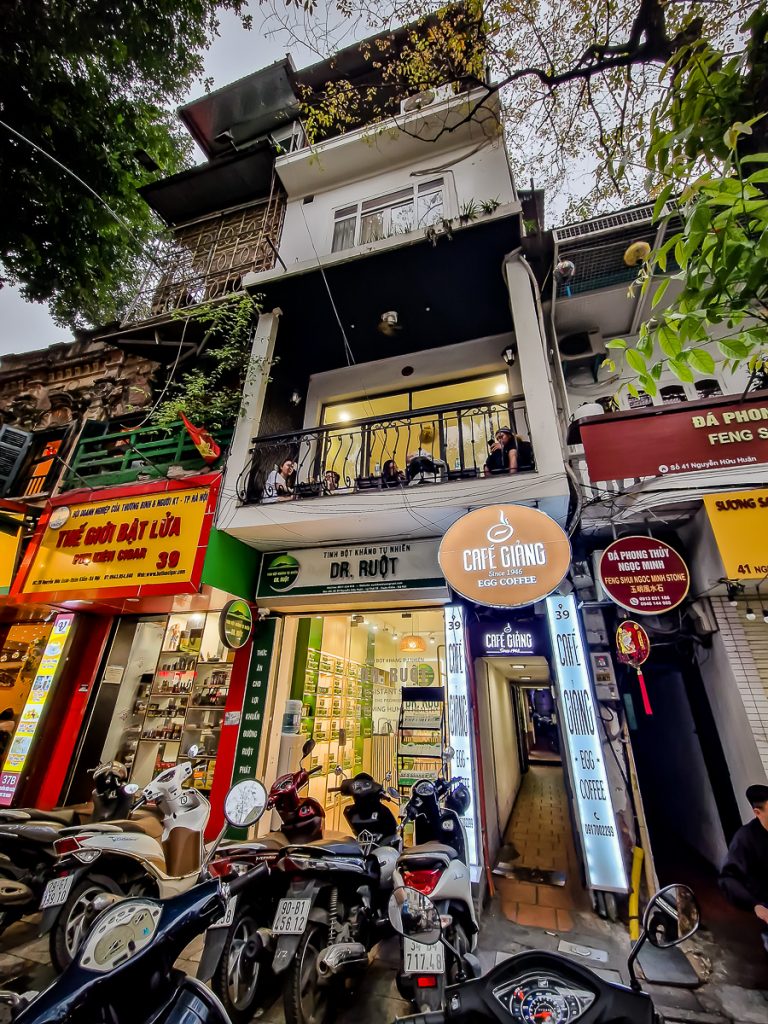
Somehow hidden on a small street in the city, Café Giang is the mother of egg coffee! Well, the father, because it was invented in 1946 by Mr. Nguyen Van Giang, and the story is quite amazing!
The man worked as a bartender at the 5-star Sofitel Legend Metropole Hotel in Hanoi. Due to the milk crisis during the war at that time, the French were missing their “café au lait”. Mr. Giang, to get rid of their complaints, thought of a substitute. So he started beating egg yolks.
And he also opened a café.
Café Giang has been moved twice from its beginnings until present, but the egg coffee recipe is almost the same as in the early days! According to his son, who currently manages the business, the main ingredients of “egg coffee” are chicken egg yolks, Vietnamese coffee powder, sweetened condensed milk, butter, and cheese.
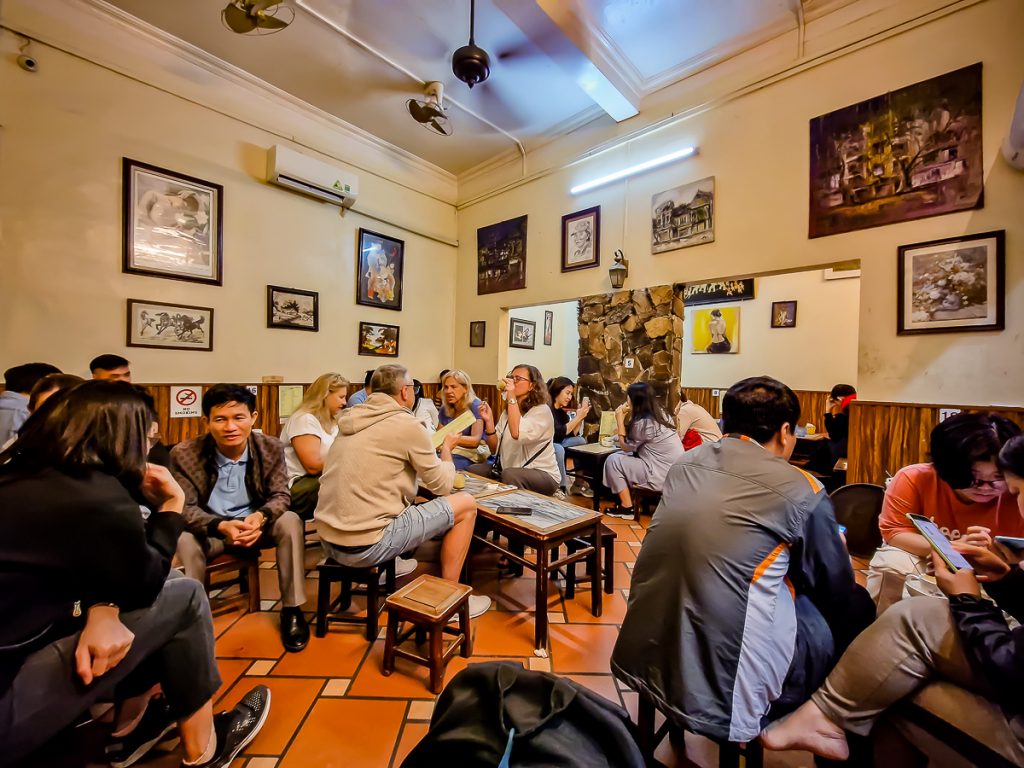
Even though I arrived in the evening at the café, the place was full!
I sat on a small chair at a table and directly ordered the “egg coffee”. It came quickly, the cup placed in a bowl of hot water to maintain the coffee’s temperature.
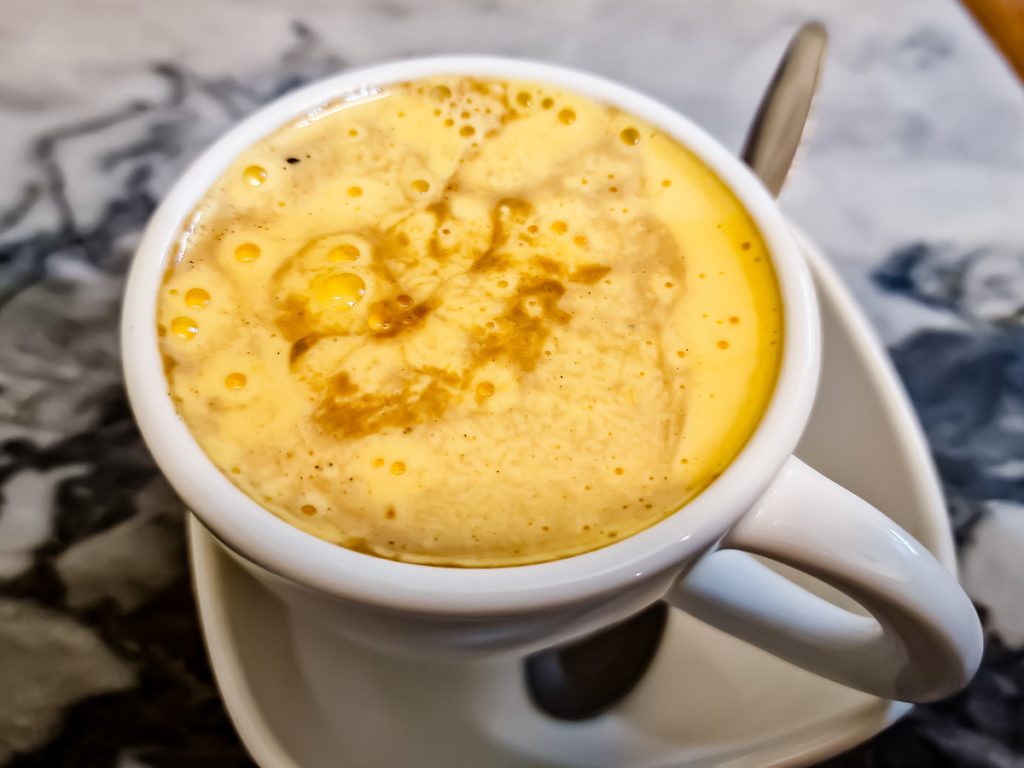
I sipped it – more the egg haha. It reminded me of my childhood when, lacking desserts, I used to beat egg yolks with sugar in a cup until I got “something sweet”.
As I slowly sip it, trying in vain to seem like a coffee drinker, I look at the menu. That’s when I noticed I could order cold egg coffee as well. Because there’s a cold version, not just hot. But brace yourselves, they also have egg beer and egg coke! I didn’t dare to try them…
My coffee cost 35,000 dong, which is around 1.38 euros.
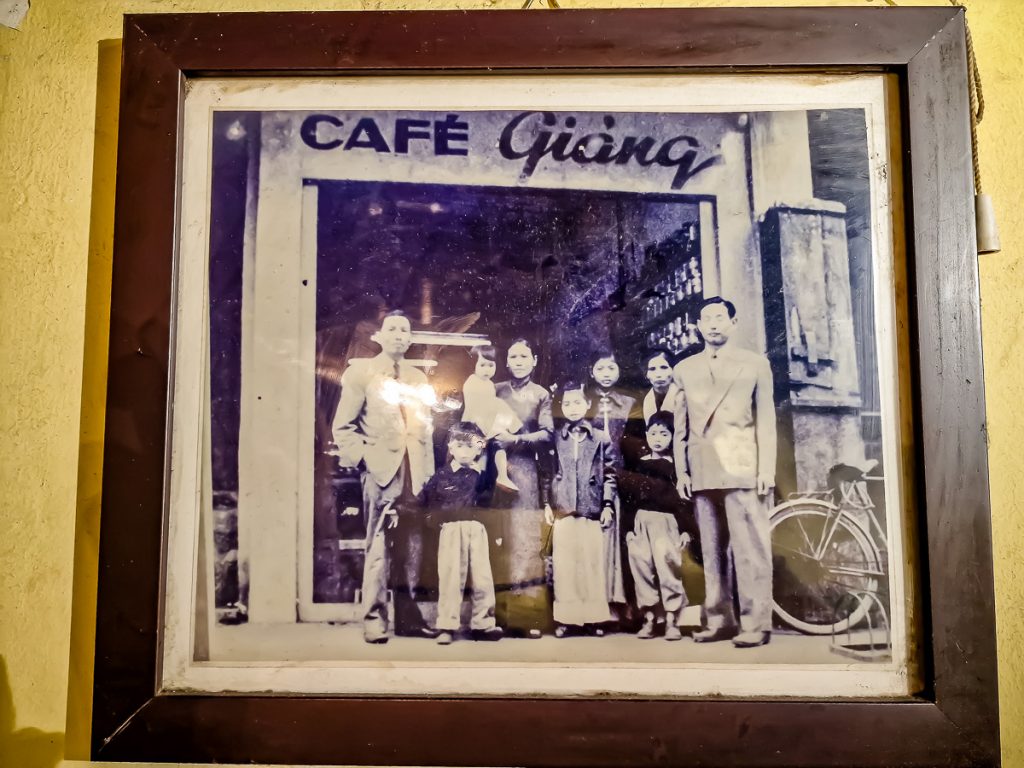
I had no idea that a few days later, I would see a picture of the Giang family in another café where we ended our food tour. It’s one of the locations where Mr. Giang’s business operated.
A very, very old house, right in the heart of the city, a house where four families once lived together.
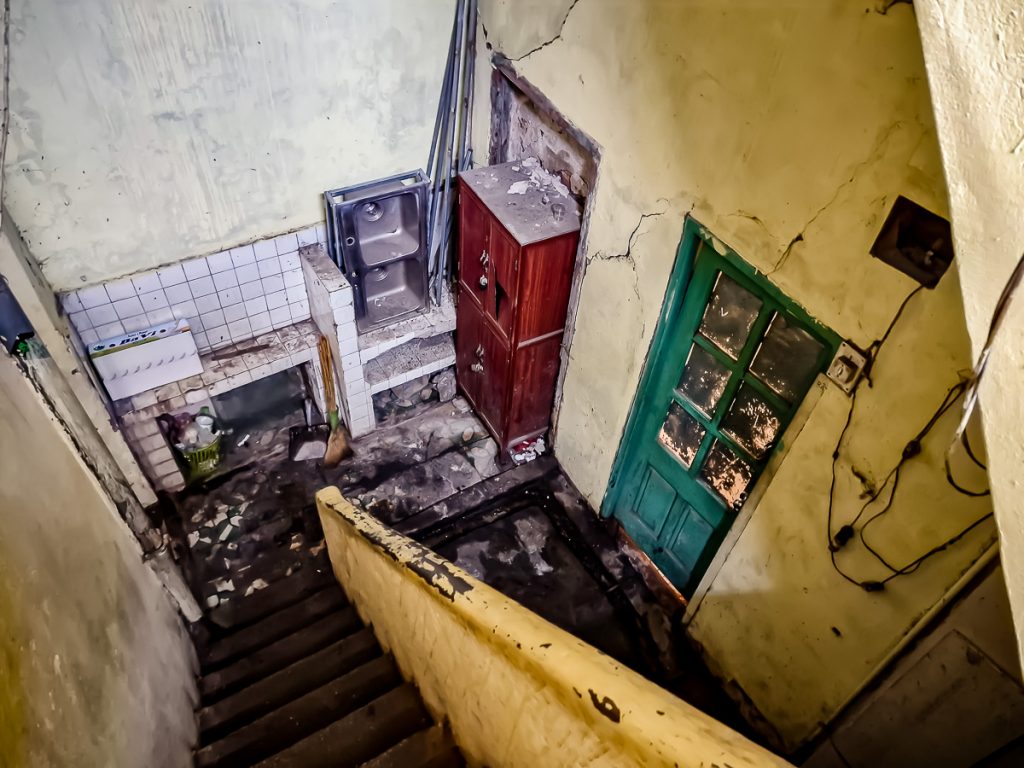
If you’re not deterred by the ground floor where the kitchen and bathroom once were, you can climb the stairs and enjoy “egg coffee” in a friendly little room where you can even see how your drink is prepared.
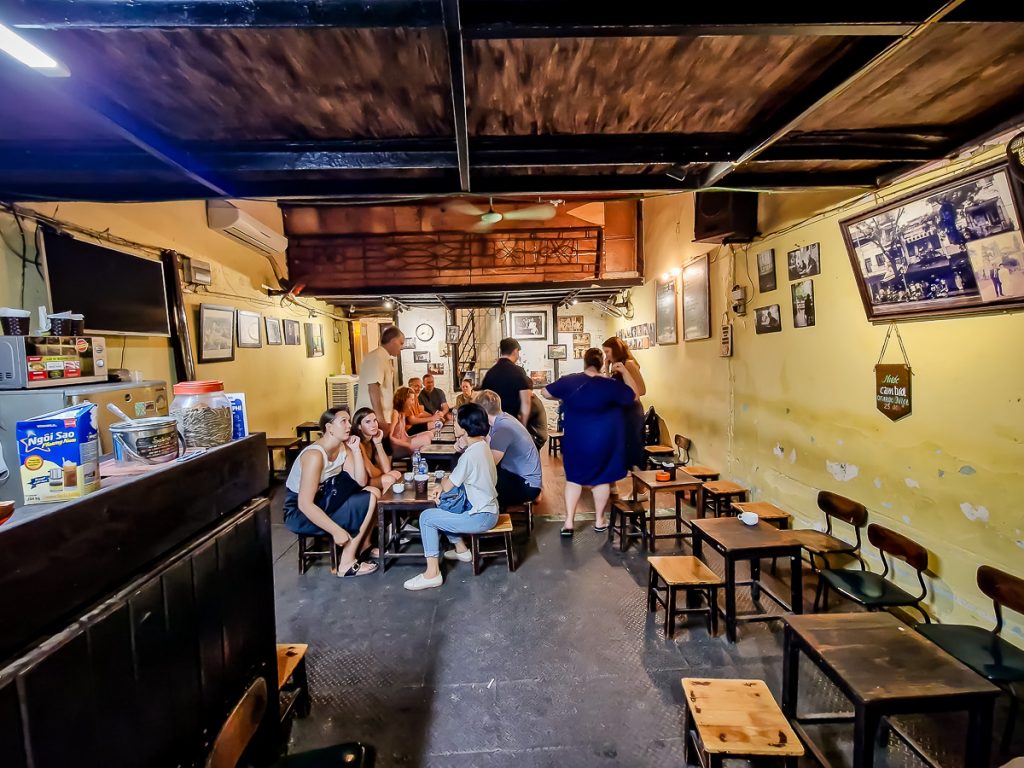
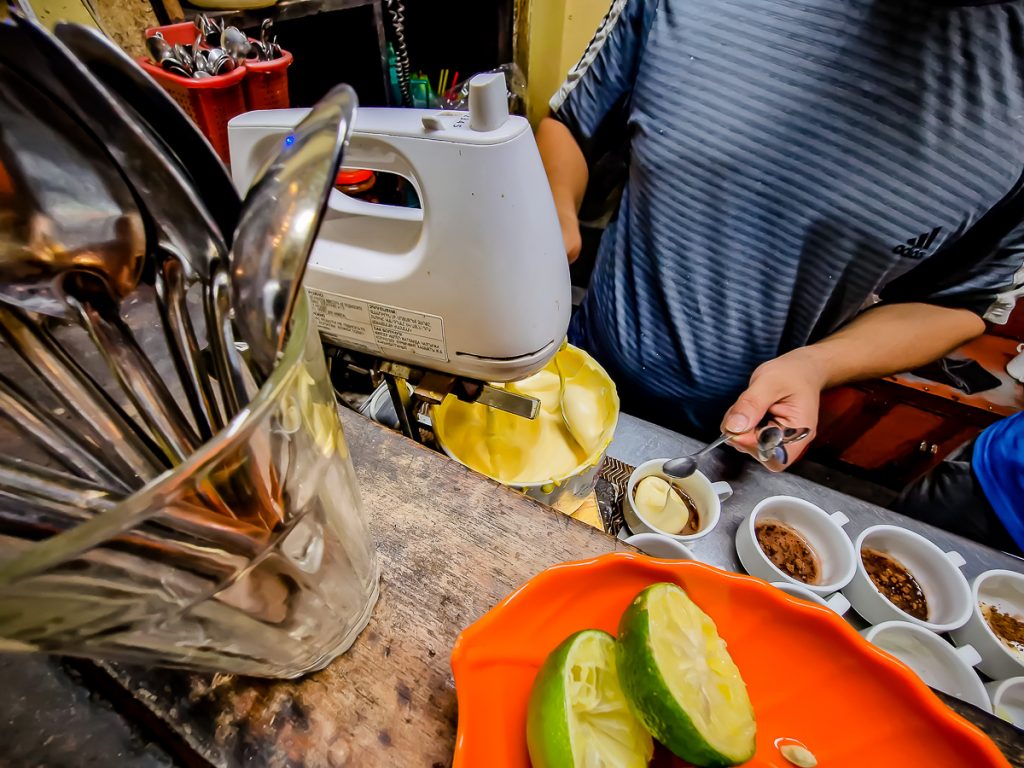
This time, I thoroughly looked at the menu and chose “egg cocoa” so I could enjoy it to the last drop. Because I get along well with cocoa…
The culinary experience continued, and even though I thought I knew a lot, I discovered more dishes because, as the area changed, so did the type of food. So, I will return “region by region”.
SNAKE TO EAT
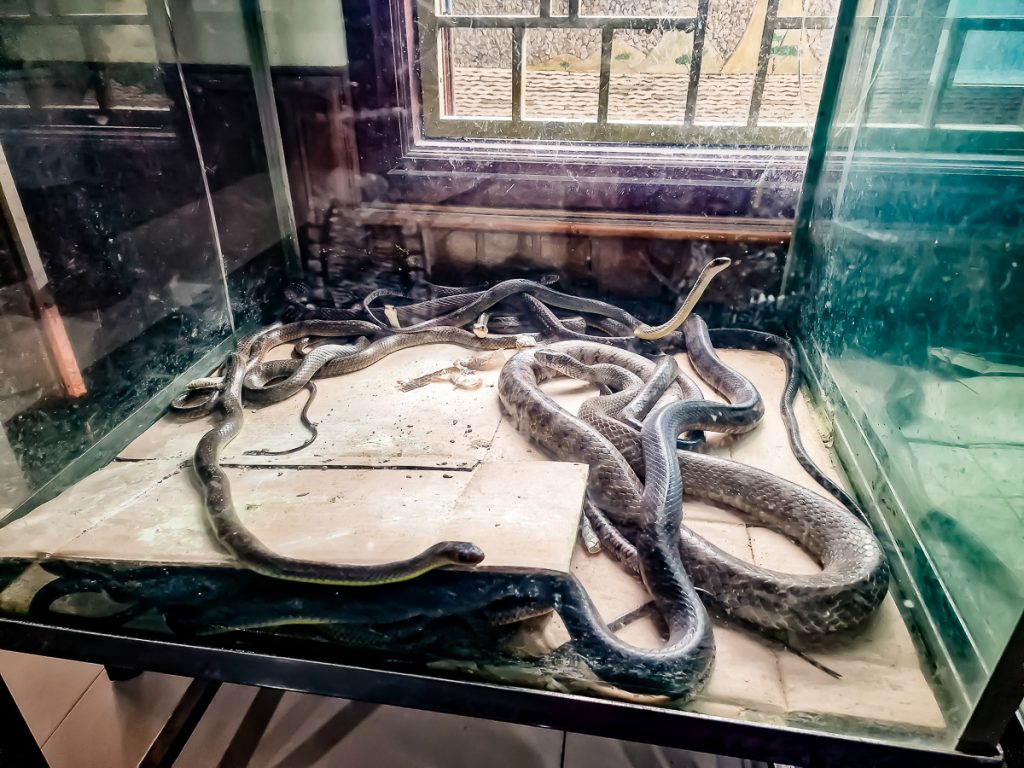
I have eaten snake only once before. Many years ago, in Hong Kong, where I ordered snake soup. I had the sensation of eating chicken, and the broth was a bit too gelatinous for my taste. But it worked, and I boasted later that I had eaten snake… (Well, a few small pieces.)
In Vietnam, snake isn’t cheap at all compared to other animals. I’ve met Vietnamese people who told me they have eaten snake only twice in their entire lives.
SNAKE MEAT RESTAURANT
Nguyen Van Duc 2 – I show the taxi driver the note the hotel receptionist wrote for me with the restaurant serving snake.
“Snake,” he says and I confirm. “Very famous!” he continues, which makes me understand that this place, located far from the center, across the river, is well-known.
I arrive in a poor neighborhood, deserted at that lunch hour. Deserted, including the restaurant. In essence, it was just me and the staff. They were friendly, but didn’t speak a word of English.
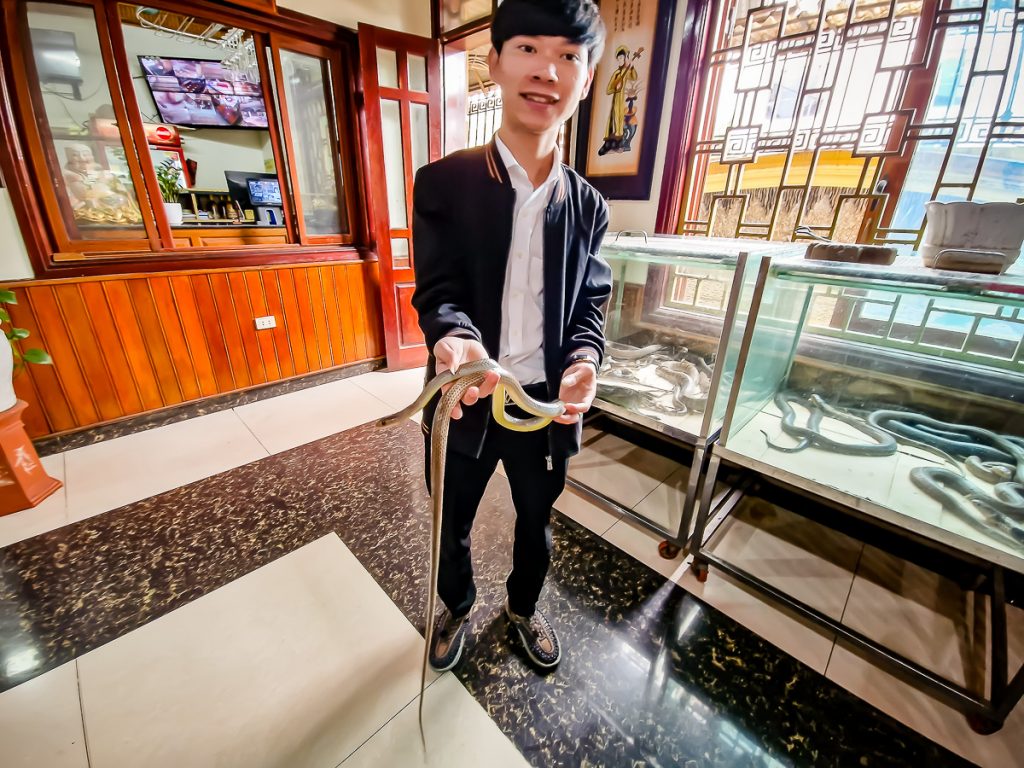
The waiter picks up a slender snake from an aquarium and tries to explain something to me. Then he places it in my arms for a photo.
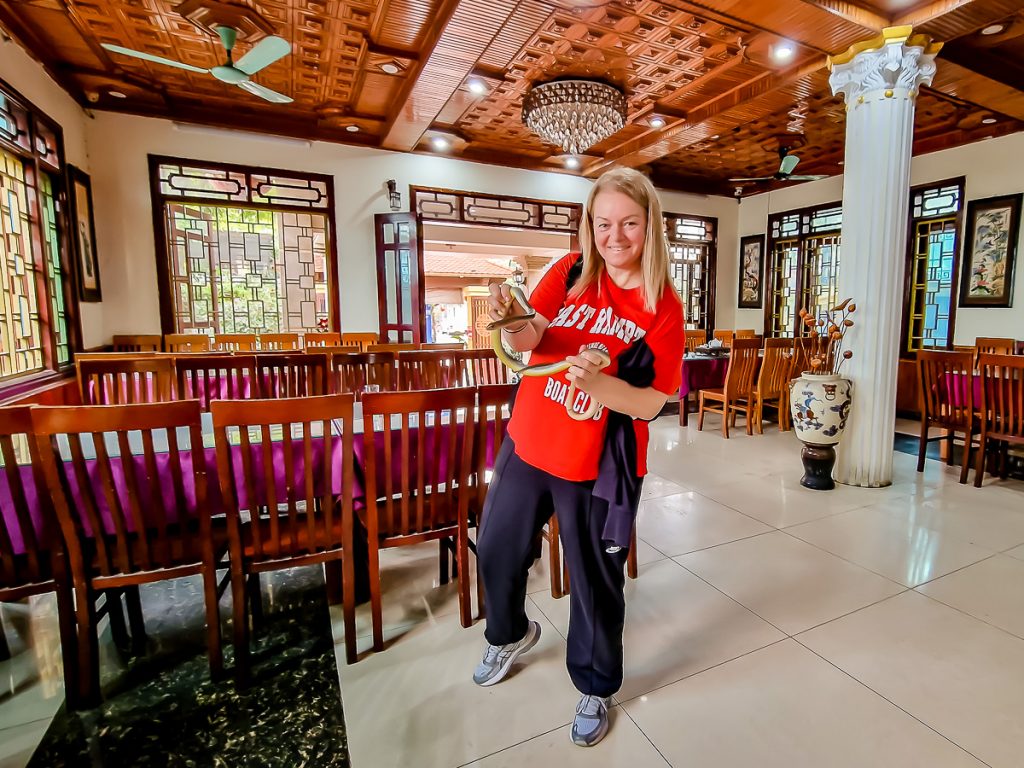
Not understanding what he’s saying with the snake and without the snake in my arms, he puts it back in the aquarium and brings a menu. Oh, no, don’t imagine it was in English… Everything was written only in Vietnamese.
He shows me several pictures, then stops at one page.
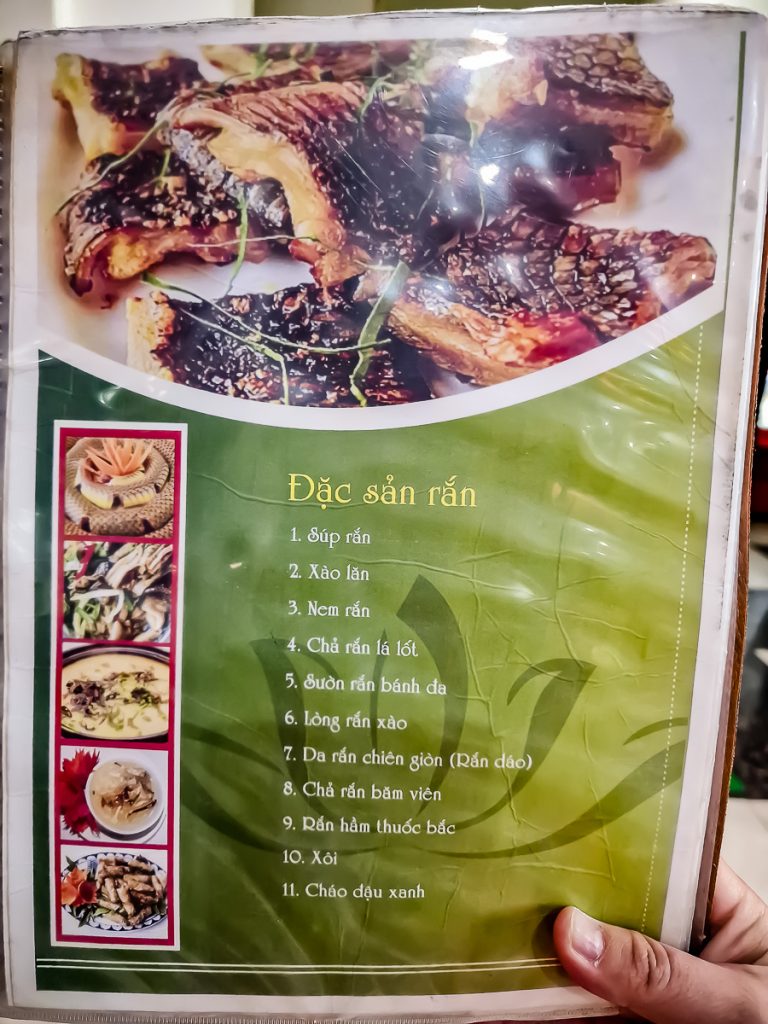
He explains that I can have a complex snake tasting: 11 dishes. 40 euros in total. I say “ok” immediately.
He reaches into the aquarium again, takes out a snake, and presents it to me asking something like “Good enough, madam?”. I only snap out of it when he and a colleague call me to the back, signaling for me to film with my phone, as they are about to… kill that snake!
He shows me an empty bottle, asking if I want it filled with something from the snake (blood???), I quickly say noooo, then I have a second to step back, so I don’t witness the killing of that snake (which the second guy was about to hit against a wall).
I go upstairs, sit at a table, and remember that I did indeed read that in such places, people kill the snake in front of you, then cook it. All of it! They waste nothing, turning every bit of snake into something to eat. There’s nothing pre-prepared, everything is done right there on the spot. So, you can’t say you haven’t eaten fresh snake 🙂
Now I understand: that snake will indeed transform into those 11 dishes.
With Google Translate, I managed to find out that the restaurant is full in the evenings. Both tourists and Vietnamese come.
After a long wait, the plates start coming. As he brings them to me, the boy with the snake points to the corresponding number in the menu for each plate (since they don’t come in order) and tries to translate – he with his hands, me with Google Translate. We don’t reach any result, so I make a decision: I won’t ask anymore, but I’ll eat what my brain and stomach allow me to eat. BUT I take photos of the menu, intending to ask the guide I was going to meet soon what each item means. That’s how I find out, with a delay of a few days, what I ate:
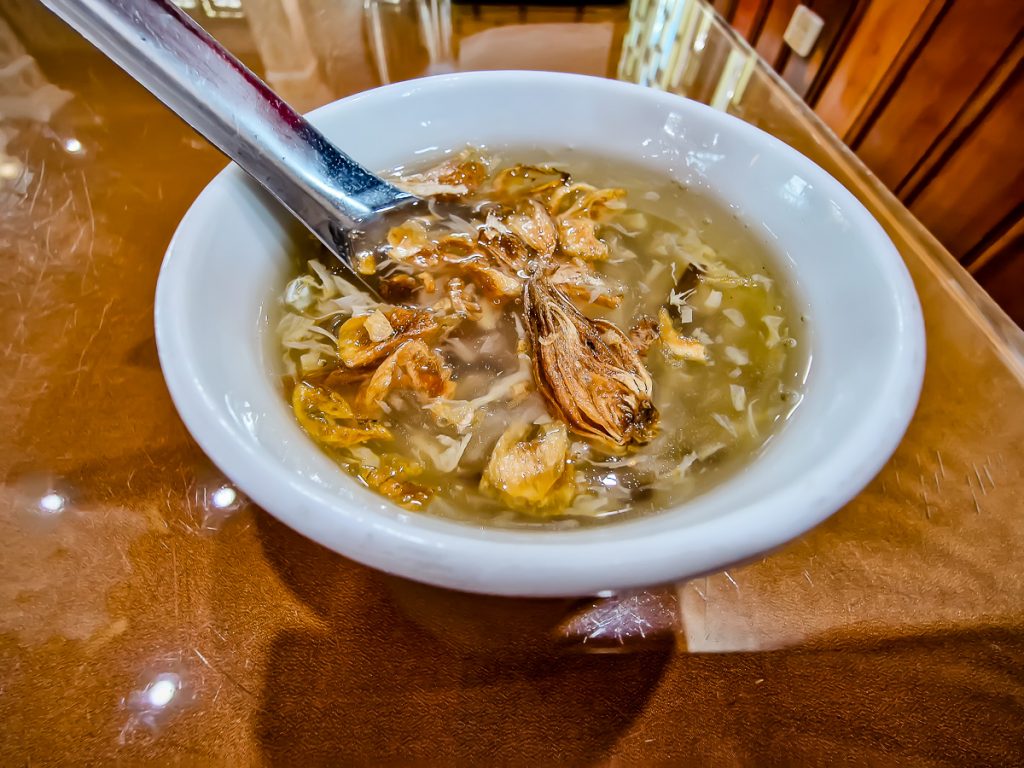
Snake soup. That was clear to me from the beginning. However, surprisingly, while I had no issues with it in Hong Kong, here it seems very, very nauseating to me. I take a small taste and that’s it. I don’t want to have an unhappy start to this experience.
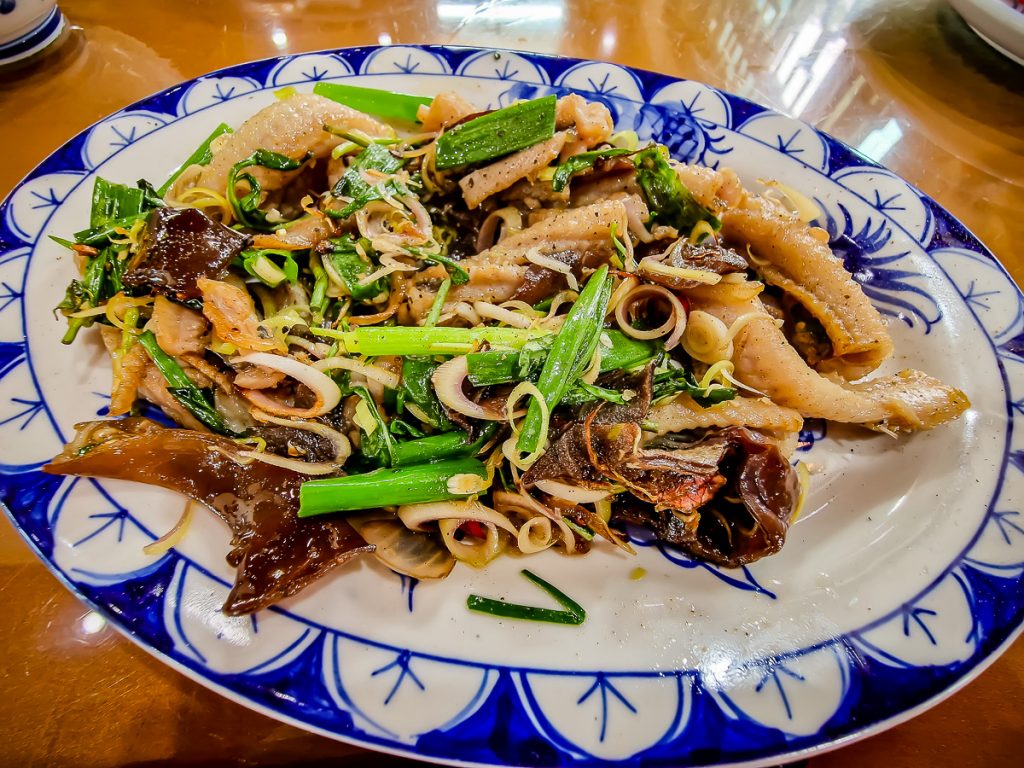
Fried snake. I really can’t fault it, perhaps because it tastes similar to a meat I eat in my everyday life.
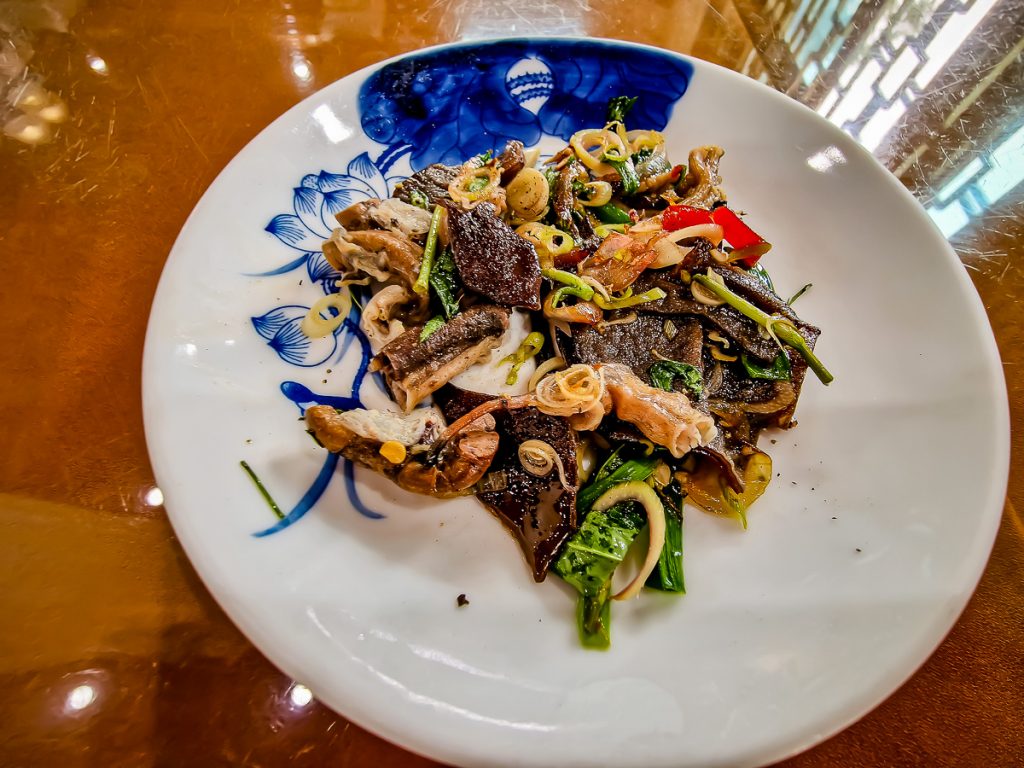
Fried snake intestines. Well… this is where they lost me. I try a small piece, but I can’t manage more. I wouldn’t want to have my intestines spilled at their restaurant.
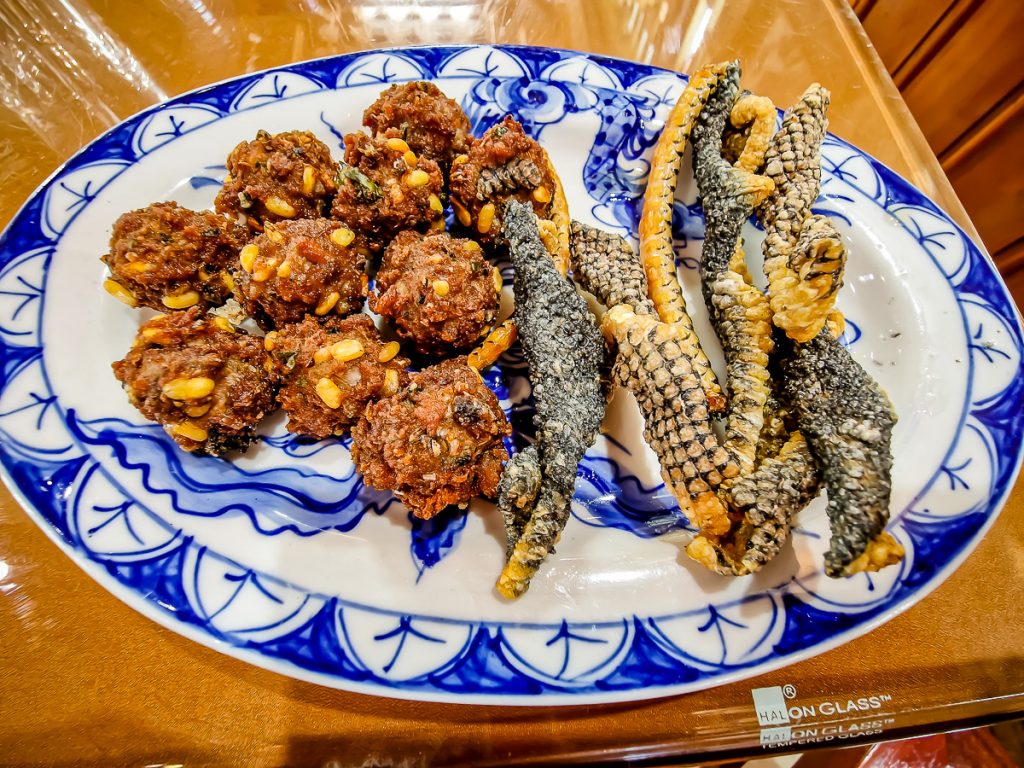
Snake meatballs. Very good! Tasty! And crunchy snake skin, a sort of snake chips. Good, but heavy…
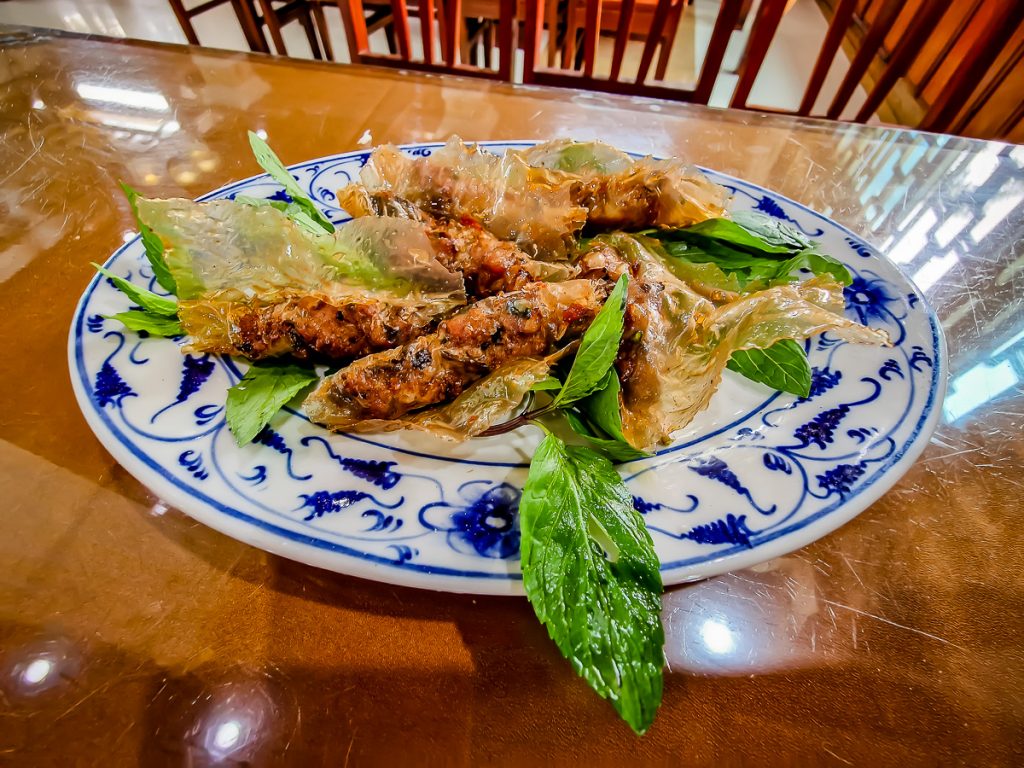
Spring rolls with snake meat. Delicious! Really good!
What really bothers me is that I don’t have any bread with these dishes. It feels like I want to have some bread to keep my stomach under control…
I search on Google Translate for “bread” in Vietnamese and show it to the boy, accompanied by a desperate question: “Bread??”…
He looks at me as if I’m speaking gibberish and immediately replies: “No!!” It seems abnormal to want something like that. Damn! I start to feel not butterflies in my stomach, but rather beetles.
What do you think I do? I ask for a Cola as a substitute for bread. And I see that it works, haha.
The dishes keep coming.
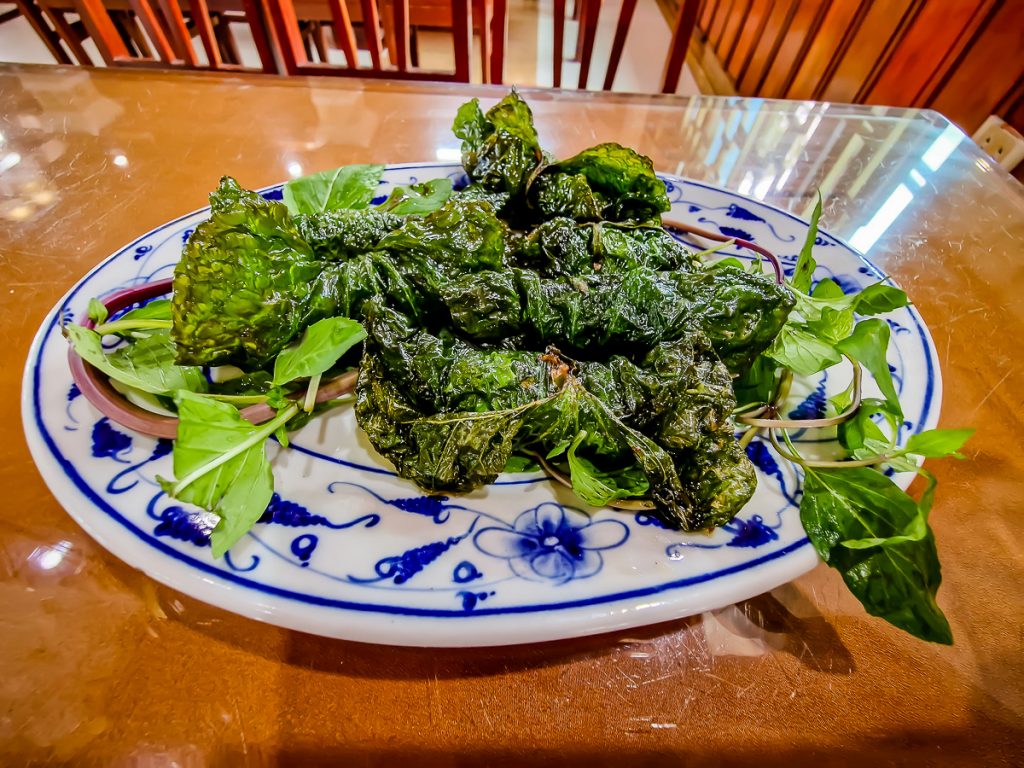
Snake meat in La Lot leaves (fried). Just the name makes me search the internet to see what leaves these are.
Anyway, I enjoy this dish! I eat it with pleasure, without thinking about what these leaves conceal, besides the snake meat…
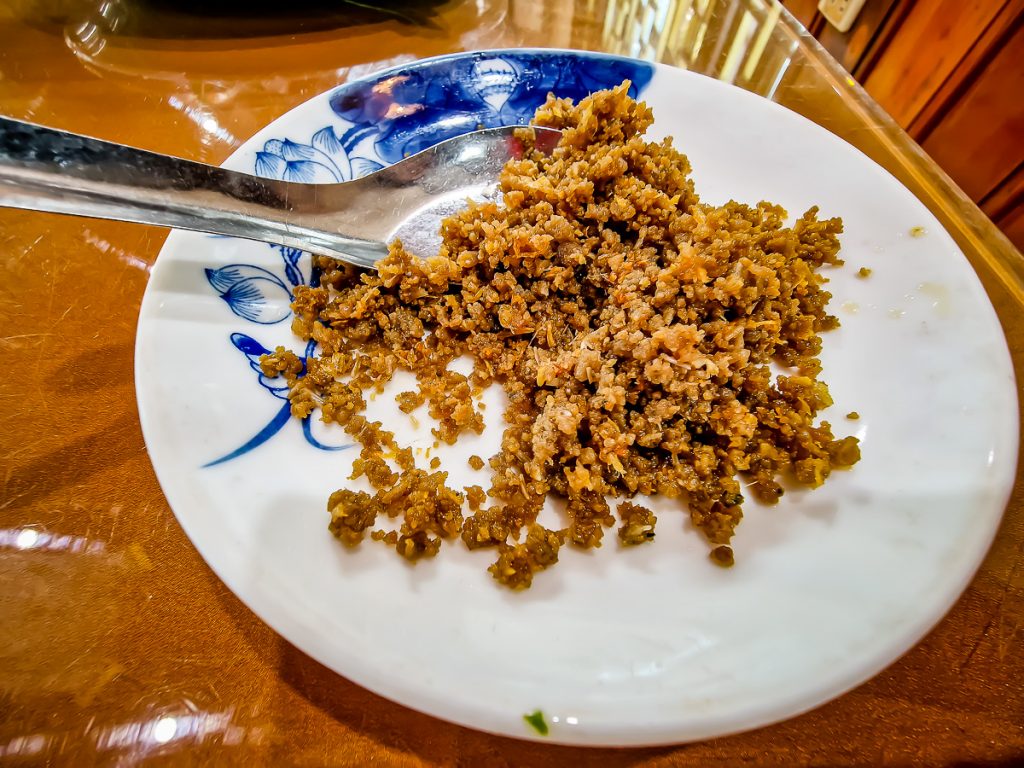
Snake ribs. What?!? I wouldn’t have thought of that… Snake ribs??? In the dish, there is a kind of… pebbles, and I’m told to eat them with rice crackers. Oh my, crackers!!! Imagine that I eat them instantly, reminiscing about all the dishes before where they would have been really helpful.
The ribs are okay. Crunchy. But heavy too.
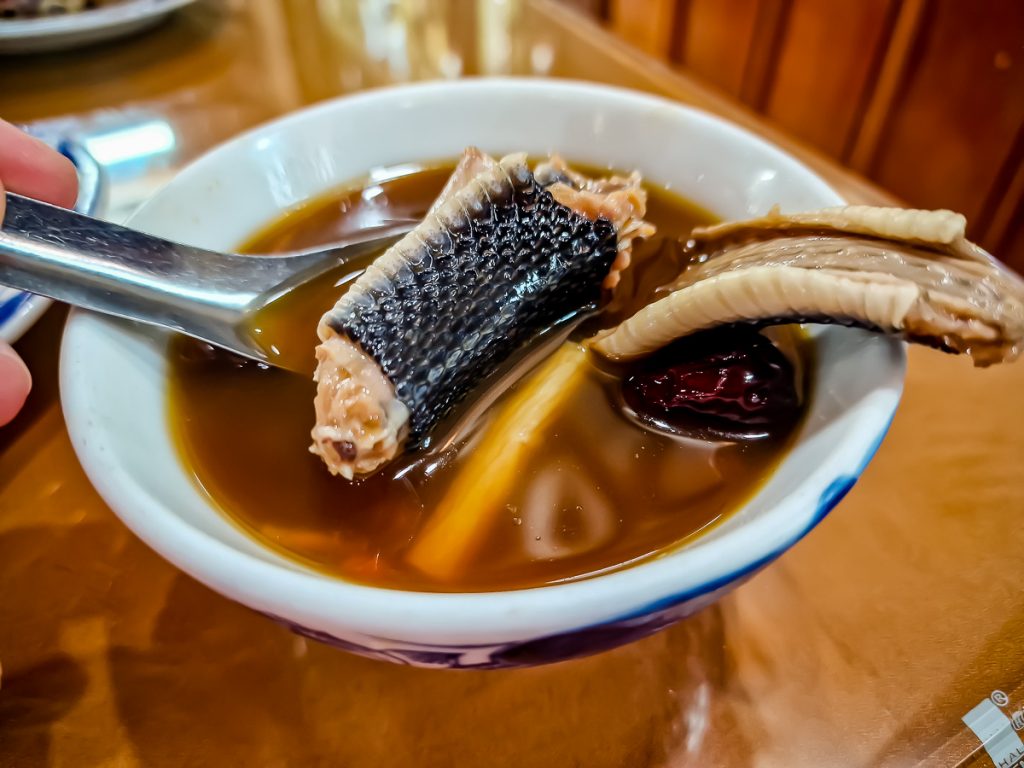
Snake meat simmered with “traditional medicine”. It’s a broth of herbs and plants with pieces of snake similar to those small fish pieces with bones where you can’t separate the meat.
I take a little taste of it and instantly abandon it. It seems dreadful to me.
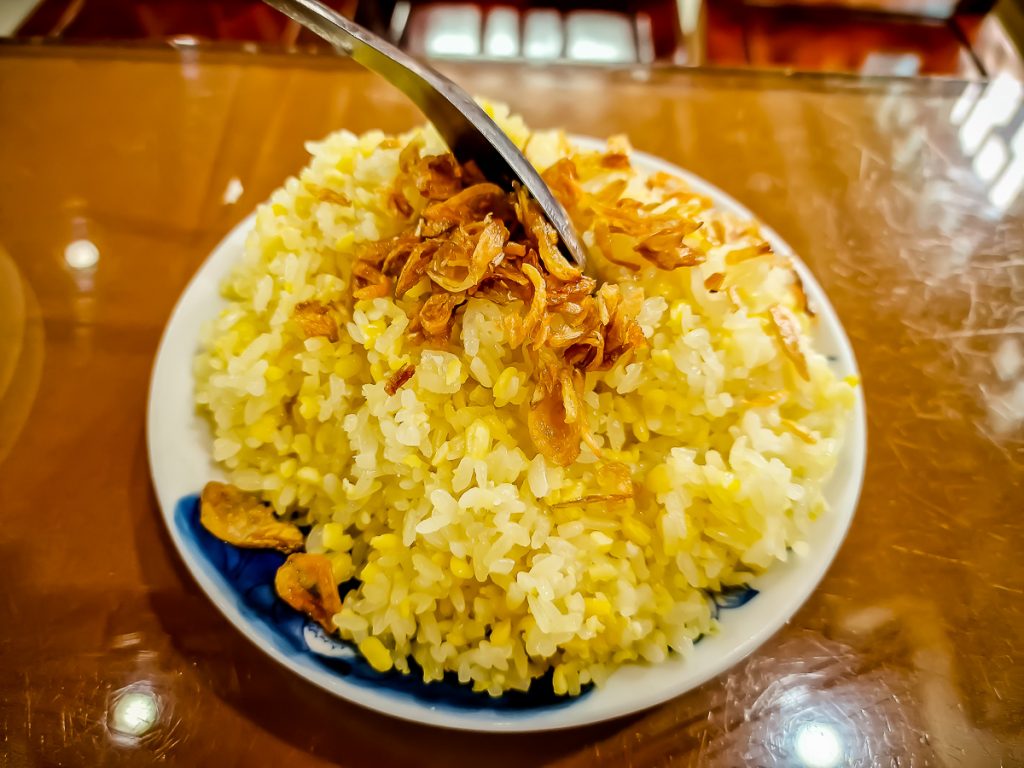
Rice. Really?? Now, at the end??? When I was craving bread, this rice would have been perfect.
I try to take some from the bottom of the bowl (as it looks like onions on top) to help settle my stomach.
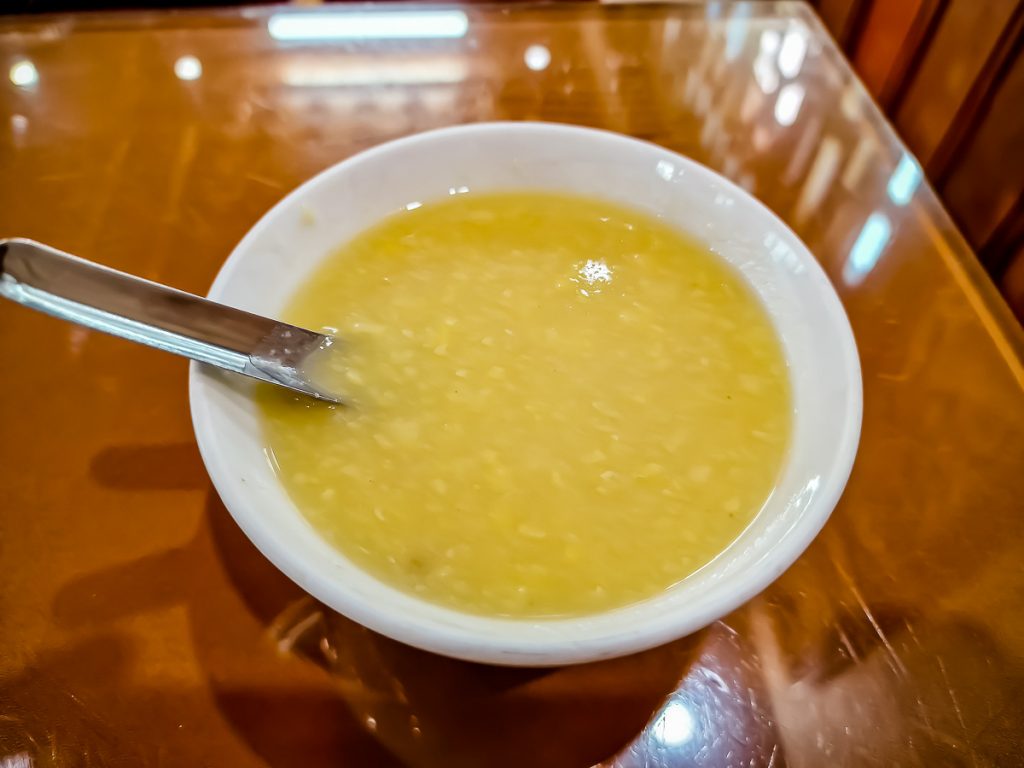
Green bean soup. It looks more like semolina in a dandelion broth. Anyway, not knowing what I was eating at that moment, I put a bit on the tip of my tongue and instantly reject it…
To see how the brain works. If someone had told me beforehand that it was green bean soup, I would have definitely eaten it. But in my mind, there were many scenarios with snakes. Well, with “a snake”, because only one was sacrificed for me.
And that was my lunch. I hope the staff enjoyed the dishes I barely touched because it would be a shame for the sacrifice made.
Leaving the restaurant, a huge duck (I’ve never seen one that big) is loudly conversing with a rooster, both locked in a cage. Hm… I have a feeling they are also headed for a hot pan.
Back to the center, in the taxi, I realize I have a problem: I have some snake stuck between my teeth, haha. Let’s consider that I ended up with a souvenir!
EATING DOG IN VIETNAM
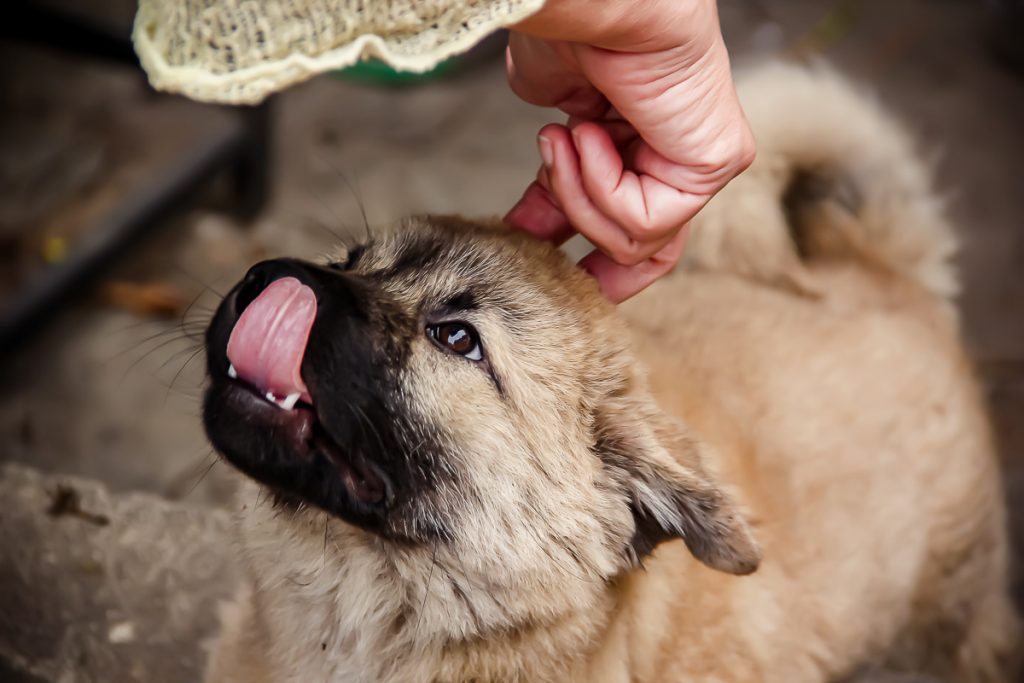
Do you have a strong stomach and nerves? If not, stop here…
…………………………
Before going on this vacation, I read about the Vietnamese custom of consuming dog meat, among other things.
Vietnam is second to China in dog meat consumption. However, oddly enough, only a minority eat it!
Consuming dog and cat meat is legal in Vietnam, but it seems that more and more Vietnamese are giving it up, and the government is also trying to limit this practice to demonstrate that “they are entering the realm of civilized nations”. Additionally, the most widespread religion in Vietnam is Buddhism, which prohibits the consumption of dog meat.
You can imagine that I was curious to learn more, and even find restaurants in Hanoi, where I spent the first week, that serve dog meat. So, I started asking around.
When I saw these cages, I wondered if they were puppies for eating, but seeing how scrawny they were, I quickly felt relieved. Then I translated what was written on the man’s sign: dogs for sale.
You come across such puppies in cages, which people are selling. As pets.
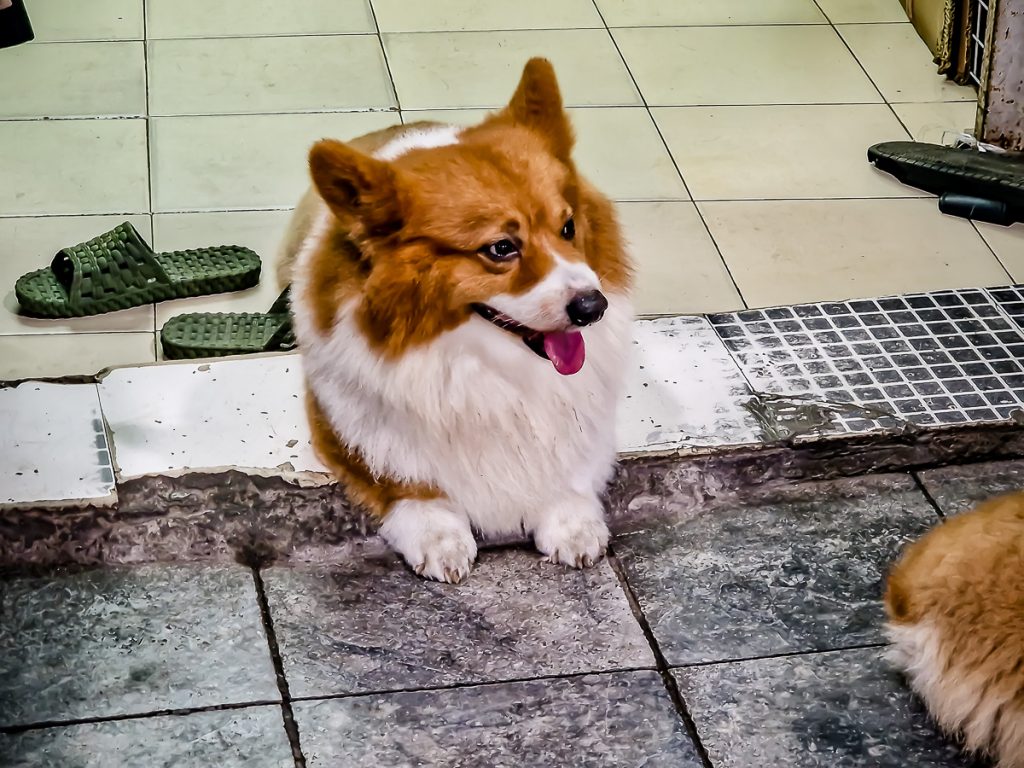
WHY DO VIETNAMESE EAT DOG?
Because they enjoy it! 🙂 Everyone I asked confirmed this to me. Vietnamese people love dog meat!
“Is it good?” – I asked. “Good??? No, it’s delicious!” was the response I got. I know it sounds harsh. But it’s not like you’re eating your pet dog… These are dogs specially bred for this purpose, in farms where they raise pigs, cows, and chickens for consumption as well.
However, things shouldn’t just be viewed at the level of taste buds. During the wars that Vietnam went through, food of any kind was a luxury. Enduring terrible famine, these people tried to survive and sought solutions…
Since the wars, the consumption of dog meat has become popular and has integrated into their culture.
Nowadays, eating dog meat is no longer widely popular. It’s more common in rural areas. And during special occasions. Or, according to their beliefs, if something bad happens, they consume some dog or cat meat to ward off bad luck. Additionally, Vietnamese people believe they remain healthy by consuming dog meat.
It’s not a dish available to everyone, considering it’s expensive meat! Only some kinds of beef surpass its price.
WHERE TO FIND DOG MEAT
You can find dog meat in certain restaurants and specific stores.
Restaurants where dog or cat meat is consumed are specialized, so in places where they serve noodles, spring rolls, or other “classic” dishes, you won’t find such meat on the menu.
I set out on foot in search of a place that several Vietnamese people had mentioned to me, a place where you can find dog meat. I had noted to look for this: Thịt chó – dog meat.
I didn’t know in what form I would find it, assuming it would be in a restaurant. So, I began to look around in every place with a kitchen along my way. Nothing… No dog.
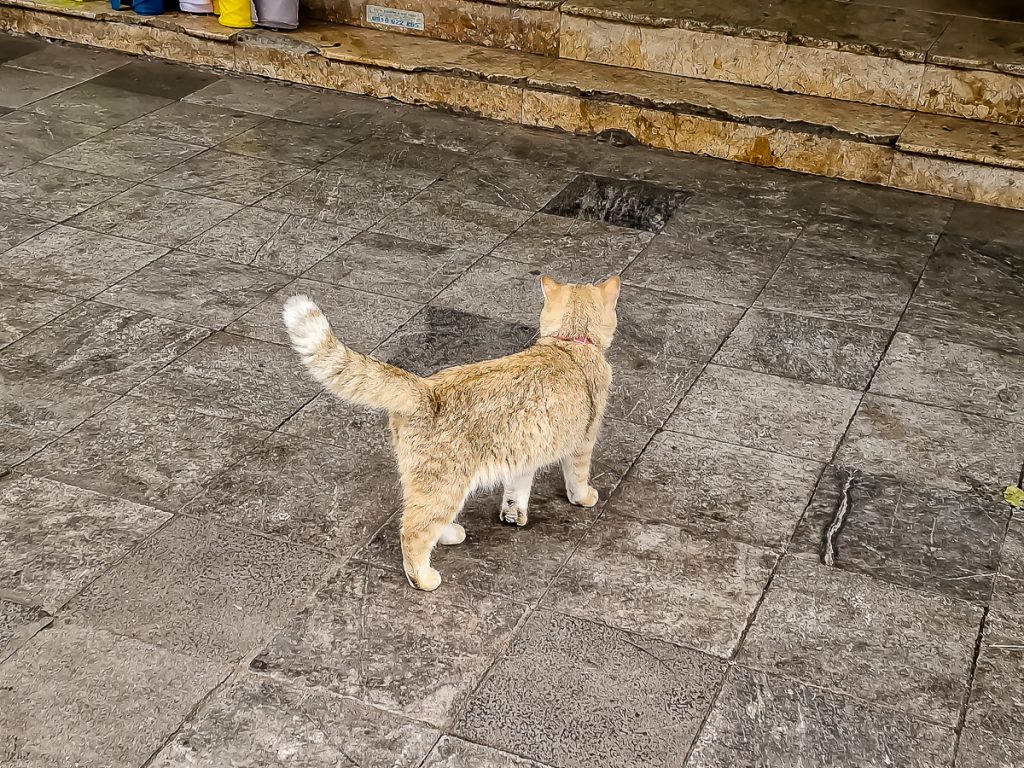
Instead, I came across a beautiful and friendly cat, and I remembered what a Vietnamese person told me, that he had eaten both cat and rat, not just dog. (Rat from a farm, not from a hole in the street…) “Cat is not as popular among Vietnamese as dog”, he explained.
When I asked him about the taste, he said that cat tastes similar to rabbit, while dog is “more like pork, but healthier”.
Just when I was contemplating giving up on my search for dogs, I stumbled upon stalls selling dogs.
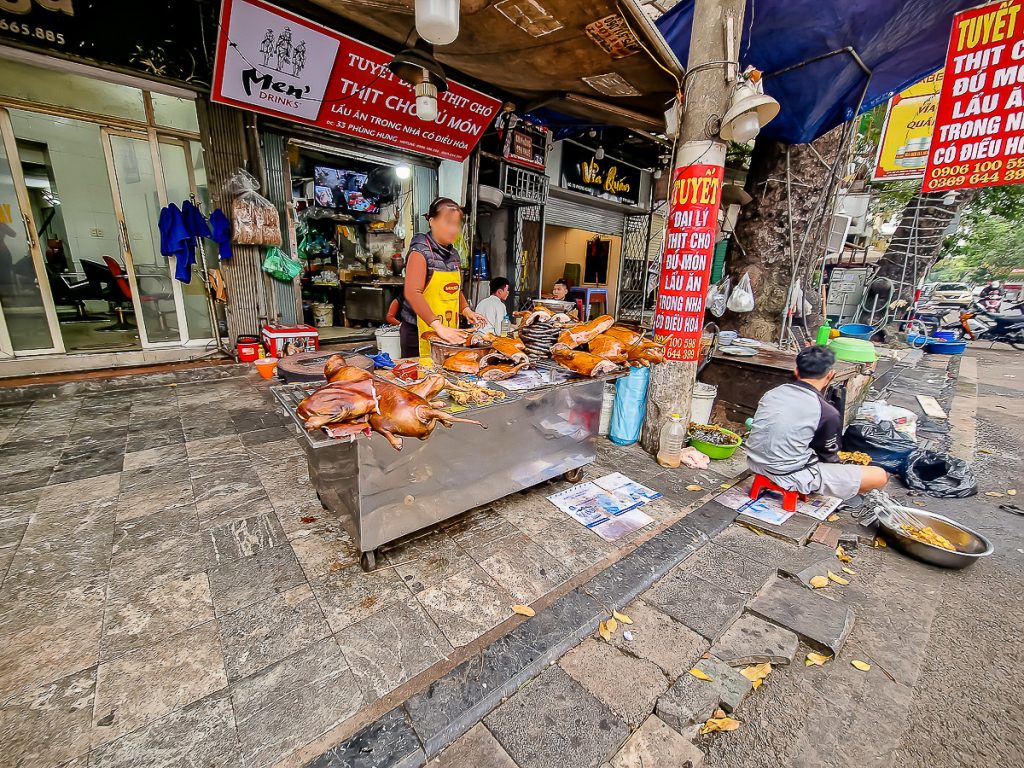
I must admit, I had mentally prepared myself beforehand; otherwise, if I unexpectedly encountered this place, I think I would have felt queasy…
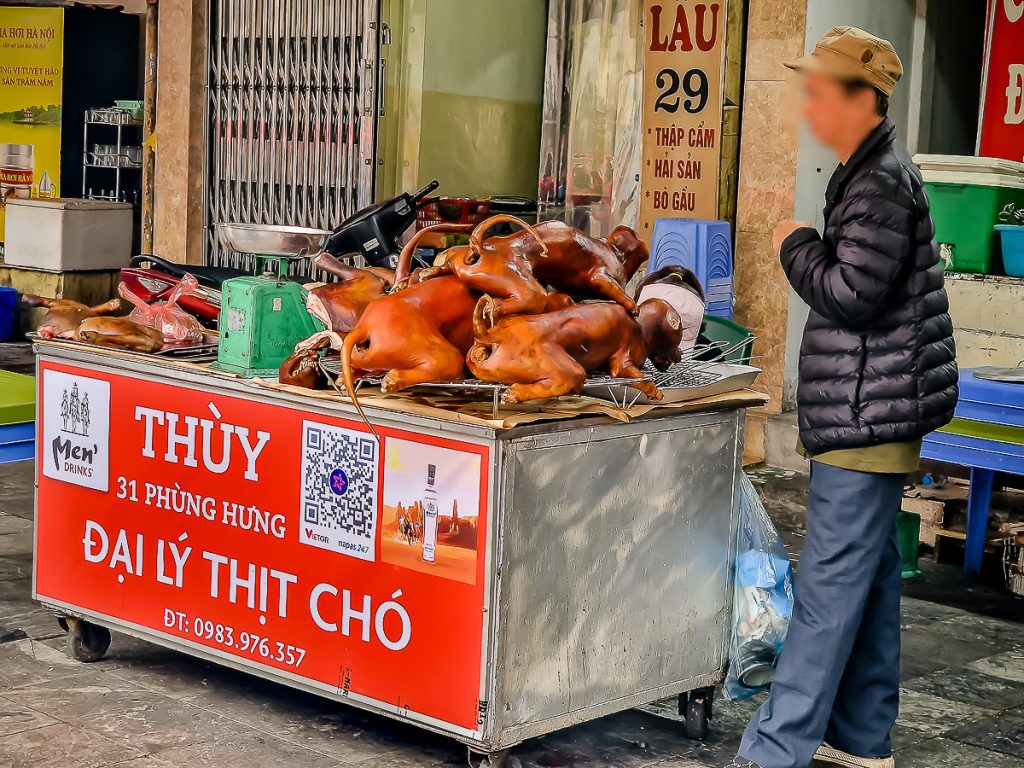
Sturdy dogs, some resembling pit bulls, were displayed for sale.
The woman was applying something oily on them. Perhaps to keep them in a sellable condition?
The man was preparing for a customer who was deciding what to buy for dinner.
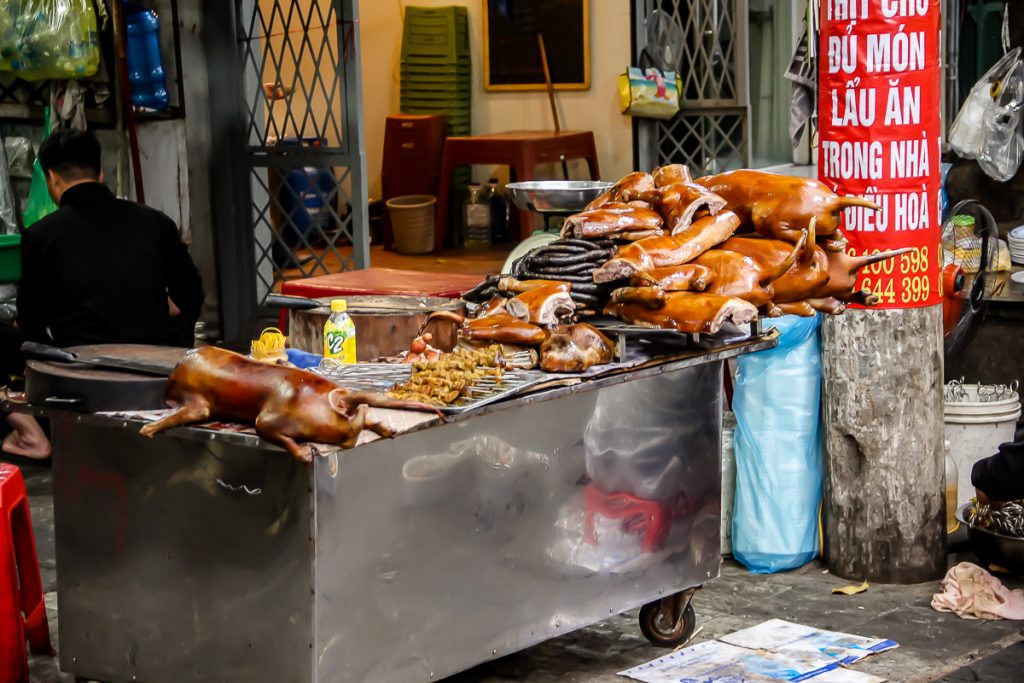
I saw, alongside large pieces of dog meat, “carcasses”, as well as sausages and skewers made from dog meat.
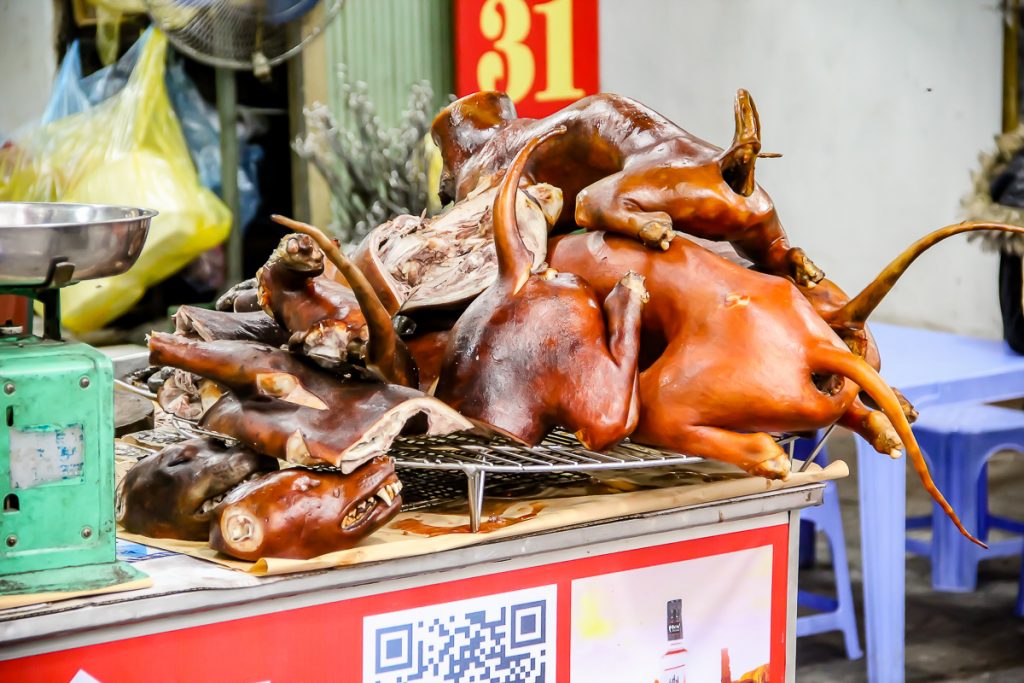
To endure these “live” images, I tried to associate what I saw with something normal from our cuisine. For example, the fish head my mother eagerly waits to put in soup. Well, the comparison doesn’t always help…
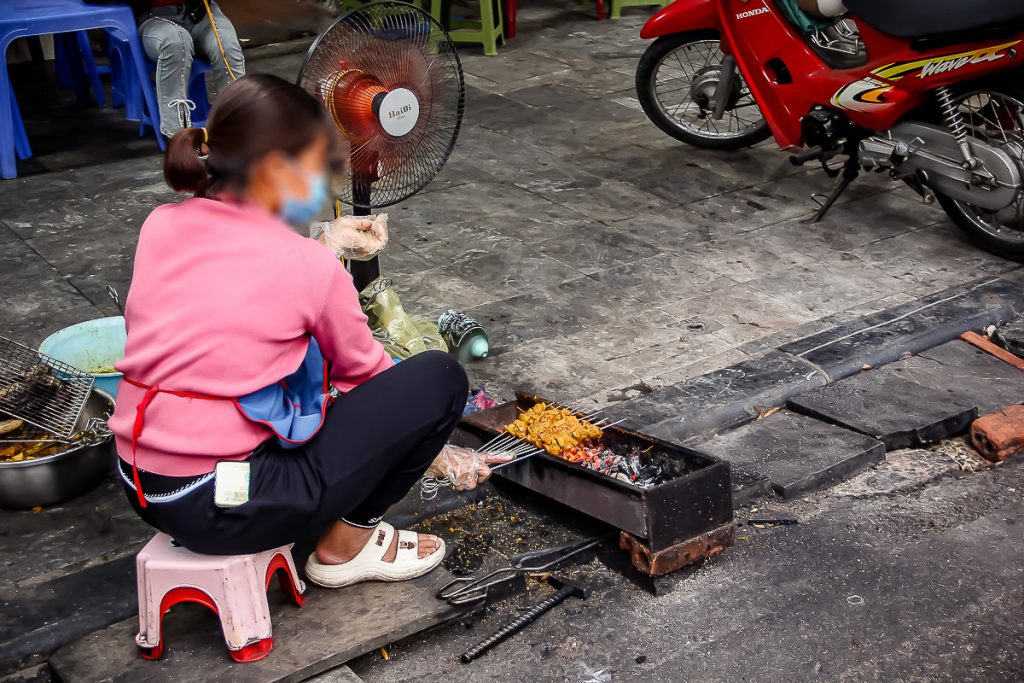
After a tour around the neighborhood, when I came back around here, a lady was making skewers. “Could I eat?” – I wondered. And my brain provided the answer, so I walked away…
However, I’m sure that living among them, tasting so many dishes you’re not accustomed to, you might end up trying dog meat one day. That’s my opinion.
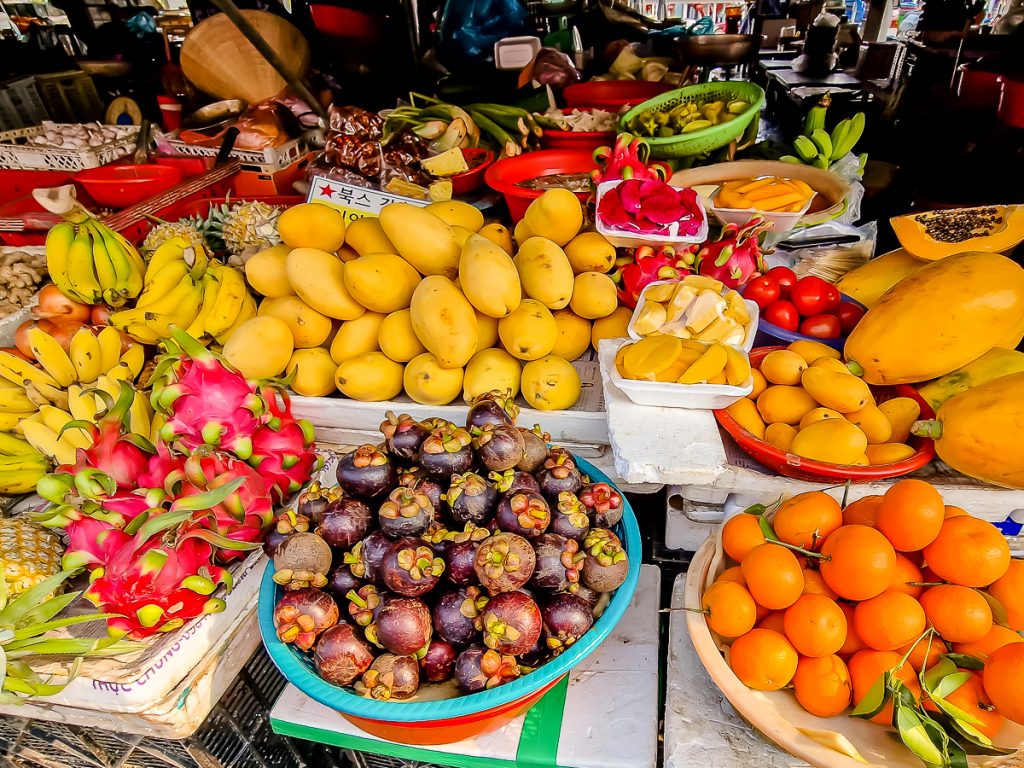
Next time, let’s recover with FRUITS, I say! Goodness, a variety of fruits!!!
Until then, for those who haven’t read, here is my first encounter with Vietnam, plus loads of curiosities.
And here, the adventurous ending of this vacation in Vietnam.


